Artists suggestions based on your preferences
Filter by media, style, movement, nationality and activity period
Search artists by name or category
Detailed results for millions of lots
Overall performance of recent notable sales
Browse all types of artworks for sale
Notable sales happening this month
Buy unsold paintings, prints and more for the best price
Upcoming exhibitions at your preferred locations
Global snapshot, top performers and top lots
Charts on artist trends and performance over time, ready to export
Get your artworks appraised online in 72 hours or less by experienced IFAA accredited professionals
Get the best price for your artwork or collection.
We notify you each time your favorite artists feature in an exhibition, auction or the press
Access detailed sales records for over 769,000 artists, and more than two decades of past auction results
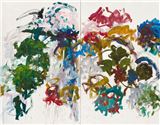

On Artists’ Journeys and Their Meanings
Many artists undertook arduous travels to reach new environments in search for inspiration. These often resulted in lifechanging experiences for artists, and treasures for art history
Bianca Spaggiari / MutualArt
Aug 29, 2023
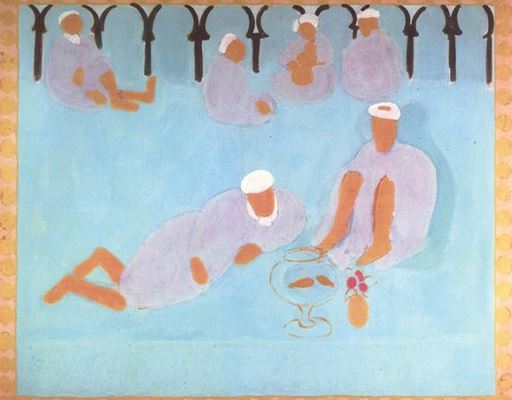
As the summer comes to an end, most of us look back on our recent journeys – be it far or close. Off a plane, onto a train, and then a boat. All steps that are quick and casual to modern man. This ease of displacement wasn’t always the case, however. Nonetheless, in their search of inspiration, artists of the past centuries overcame tough travelling conditions in order to undertake life-changing voyages. Common threads exist in the way artists used to travel and the motivations behind those undertakings, most notably that no matter the length of the trip, the real journey was always the inner one.

Vincent Van Gogh , The Langlois Bridge at Arles with Lady and Umbrella, oil on canvas, 49.5 x 64 cm, 1888, © Courtesy of Wallraf-Richartz Museum, Cologne
Vincent Van Gogh , incapable of fulfilling his family’s plan to become a clergyman, at thirty-one left the emerging Dutch art scene and moved to France, aiming to dig deep into the depths of his personality. There, Van Gogh started painting landscapes, a booming genre at the time. This was a common initial feature to many artists as they shifted to a new environment. As time went by and they became more acquainted with the area, they often decided to focus on details, those that visually define the place. In the case of Van Gogh, he arrived in Arles amidst snowfall in 1888. Several weeks later spring sprung, instigating a highly prolific period for the artist. He produced nearly fourteen canvases set in the blossoming fields of the town, first focusing on the Langlois Bridge on the Arles Canals, and then on specific types of trees. The colors he applied in the Provence stand at odds with those in the rest of his paintings. The tones are softer, almost carefree and cheerful, reflecting an inner joy of the artist in beholding fresh environments. Travel allowed Van Gogh to express his (initially) relieved senses through art.

Henri Matisse , Moroccan Café, size colours on canvas, 176 x 210 cm, 1913, © Courtesy of Hermitage Museum, Saint Petersburg
Likely pushed by the same desire, Henri Matisse ventured further south to Morocco in search of the exoticism long lost in Paris. Matisse travelled to Morocco two years in a row, in 1912 and 1913, resulting in a pivotal phase of his career. Despite the initial disappointment of days of uninterrupted rain and a slight cultural clash he reported in a letter to a friend, his artistic practice benefitted extremely from the Mediterranean air and new motifs. Matisse was enthralled by the wild vegetation, and with the little he could do during the rainy days, he started focusing on the view from his window. Once he could, he began portraying tiled roofs, the blue- and green-imbued environment, and local scenes, like in Arab or Moroccan Café . The canvas depicts a moment of daily reverie, the people of Tangier gathering to leisurely sip a cup of coffee. The canvas presents blurred and soft nuances as well as a flattened surface, in contrast to other paintings from his Moroccan period, which feature strong color juxtapositions.

Paul Gauguin , The Seed of the Areoi, Oil on burlap, 72 x 92 cm, 1892, © Courtesy of Museum of Modern Art, New York
Unlike Van Gogh and Matisse, Paul Gauguin ’s move to Tahiti led to a feeling of disruption and disappointment due to the increasing Western colonization. He sought ways to plunge himself into the remotest parts of the island, the paradise lost he had been looking for. On many levels, travelling meant to Gauguin searching for a mindful quest and creative liberation, as well as denying and dismissing his origins to study and absorb Tahitian culture. In this period, he produced many portraits with gorgeous feminine figures. Te aa no areois was the original title of The Seed of the Areoi , as the majority of his works were titled in the local language. The painting portrays the order of the Areoi anachronistically, but it was meaningful to Gauguin to depict the historical narrative of the place by linking past and present. During his travels in the South Seas, he developed a more descriptive, personal and expressionistic style, slowly detaching himself from Post-Impressionism. Even if the art world may be divided over Gauguin’s personal legacy, these works served as a reference for many subsequent artists.

Edward Hopper , Gas, Oil on canvas, 66.7 x 102.2 cm, 1940, © Courtesy of Museum of Modern Art, New York
Edward Hopper , on the other hand, didn’t travel to find company. He sought to dissociate from the hustle and bustle of American society, as he also artistically denounced its fleeting moments where people felt lonely and alienated. He enjoyed driving in his car around limitless America as a solitary man. Taken by the twenty-four-hour diners, the gas stations and the neon motel signs, Hopper mentally captured those scenes and later transferred them onto canvas, ending up having too many works depicting the same themes. He found poetry in desolate spaces, inspiring the same in the viewer, without insisting. Using oil colors, he accentuated the artificial light over the natural light at dusk. The gas attendant is synonym for solitude, further dramatized by bright tones.

Georgia O’Keeffe, Red Hills with Flowers, Oil on canvas, 50.8 × 63.5 cm, 1937, © Courtesy of 2018 Georgia O'Keeffe Museum/ Artists Rights Society (ARS), New York
Georgia O’Keeffe found her resilient soul alive in New Mexico. Santa Fe at the time was a popular destination for artists. O’Keeffe was given a studio there to paint and a place to stay and she fell in love with the ubiquitous presence of nature. She spent most of her days outdoor, depicting landscape variations in her paintings, from stark desert scenes to flowery patterns and blue skies, exploring the abundance and void of colors through swaths of tints. She termed New Mexico the wilderness and wonder of the world and after visiting a first time, she came back to stay. In Red Hills with Flowers, she juxtaposes enlarged flowers with mountainous landscape made of sensuous red peaks. She asserted that “All the earth colors of the painter’s palette are out there in the many miles of Badlands. The light Naples yellow through the ochres — orange and red and purple earth — even the soft earth greens.”
To travel is to free the mind and make room for the unexpected to enrich one’s life. That is what drove artists to near and far lands, where they experienced different environments and lifestyles, resulting in highly prolific periods for them, and countless artworks for us to treasure as part of art history. Many of these works went on to serve as references to what certain places looked like, but, even more so, we can sense what impression they made on the artist. Therein lies the beauty and intimacy of painting, which, rather than just transmitting a point of view, serves as a gateway to the artist’s feelings too.
For more on auctions, exhibitions, and current trends, visit our Magazine Page
Related Artists
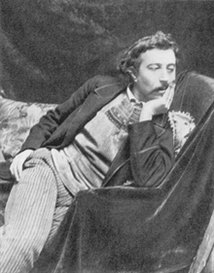
Paul Gauguin
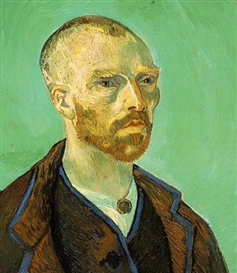
Vincent van Gogh
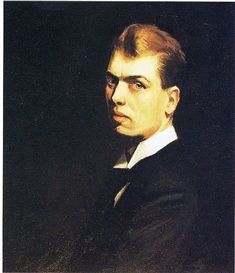
Edward Hopper
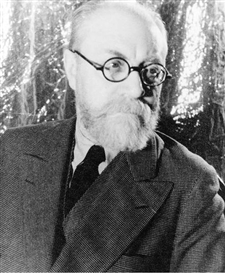
Henri Matisse
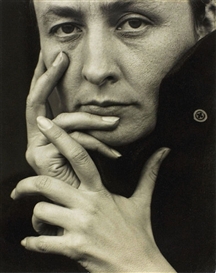
Georgia O'Keeffe

- Art Movements

Van Gogh’s Masterpieces: A Journey into his Creative Genius

A voyage into the artistic life of Vincent Van Gogh is a journey through a prism of intense emotion and dramatic imagery. Esteemed as one of the most profound and significant artists of the late 19th century, Van Gogh’s life was teeming with personal struggle and a passionate ardour for creativity. Nurturing a desire for artistic expression from a very young age, his early life experiences were instrumental in chiselling his future oeuvre. A discerning exploration of these formative years, along with an in-depth study of his unique style and technique, offers an intimate understanding of the complex man behind the canvas. His trailblazing paintings have sparked generations of study and speculation, simultaneously fascinating and baffling art critics, historians, and enthusiasts.
Van Gogh’s Early Artistic Life
Unveiling the foundations: an exploration into van gogh’s early artistic life.
Bursting with repellent brush strokes, intense colours, and a sense of emotional yearning, the art of Vincent Van Gogh stands as a testament to an individual’s earnest passion for self-expression. The early artistic journey of this uniquely creative genius reveals the influences and determination that shaped his course towards becoming a master Post-Impressionist architect.
To comprehend Van Gogh’s early creative life, it’s essential to step back into the milieu of his birth in 1853 in Groot-Zundert, a small pastoral township in the southern Netherlands. This close-knit milieu, awash with lush farmlands and church life, served as an undisputed influence on his artistic vision. An appreciation for nature’s manifold beauty and a profound sense of spirituality can be traced to these early years, reflected in many of his initial sketches and watercolours.
Related Posts

Exploring Picasso’s Guernica

Heart of the Andes Inspiration
Where to view starry night.

Van Gogh’s Use of Color
Delving deeper, Van Gogh’s intellectual upbringing played an immense role in his artistic development. Surrounded by highly literate family members and voraciously consuming an array of literature, Van Gogh was introduced to a world beyond the confines of his humble beginnings. He was particularly drawn to writers who explored the human condition, such as Charles Dickens and Victor Hugo, fueling his empathy towards common folk. These literary excursions would later echo in his art, which would pulsate with compassion, sensitivity, and a touch of melancholy.
Imperative to the forming of Van Gogh’s early artistic mindset was his stints in the art trade, ushered in by his Uncle Cent. His time in The Hague, London, and Paris, where he worked for the international art dealership Goupil & Co., exposed him to a vast repertoire of artworks, including Japanese Ukiyo-e prints which greatly influenced his style.
However, the cocoon of this artistic life started unravelling when he developed a distaste for the commerce of art, leading him down the path of isolation. Van Gogh plummeted into the depths of despair but simultaneously felt an overwhelming urge to communicate; to express. It was within this paradox that the artist was born – a heartfelt response to the tumultuous turbulence within him.
Art became a beacon of hope in these turbulent times for Van Gogh. During his pastoral duties in the mining district of Borinage, despite immense struggle and destitution, he drew tirelessly, experimenting, learning, and perfecting his craft, mainly focusing on depicting scenes from everyday life with great tenderness.
Influenced by artists like Jean-François Millet, who represented rural life with dignity, Van Gogh found inspiration even amidst his struggles. Also, it was through correspondence with his beloved brother, Theo, that his art truly evolved. They debated extensively on matters of art and aesthetics, laying the ground for Van Gogh’s understanding and application of colours, a prominent feature of his later works.
In Van Gogh’s shaping years, every adversity was channelled into creating art that defied norms, every emotion transformed into explosive brush strokes, every encounter, a source of inspiration. This essence of life experience moulded Van Gogh’s early artistic life, making him a beacon of passionate creativity even centuries later. A testament to this is his statement, “I put my heart and soul into my work, and I have lost my mind in the process.” Contained within this confession, is a captious insight into the essence of any artist’s journey: the fearless willingness to lose themselves in the beautiful madness that we call ‘creativity’.

Van Gogh’s Signature Style and Technique
The Brushstrokes of Magic Brought to Life in Van Gogh’s Art
Van Gogh’s painting style has been a feast for eyes globally, credited to his unprecedented ability to infuse raw emotions into his craft. The journey through Van Gogh’s unique style is laden with many peculiarities, each intertwined with a fascinating narrative. This tale revolves around his striking use of colour, his characteristic brushstrokes, and his inclination towards depicting reality untouched by pretence.
As one delves into Van Gogh’s palette, it is impossible not to be ensnared by his exceptional use of colour. In true Impressionist form, Van Gogh used colours not just to depict reality, but to stir emotions. He referred to colours as a means to express himself. The bright, intense hues mirrored in ‘Sunflowers’ or the deep blues of ‘The Starry Night’ exemplify his masterful ability to convey feeling through his colour choices. The colours in his canvases transcend their aesthetic values to become harbingers of emotional responses, kindling a profound connection between the viewer and the painting.
Stepping away from meticulous detail and opting for a style that favored thick, rough brushstrokes, Van Gogh forged a path of his own. His technique became an outstanding motif in his art, known as “impasto”. It gave his work a tangible physicality, an almost three-dimensional quality that elevated his paintings from mere visuals to tactile experiences. Each stroke was a testament to his tumultuous emotions and, in a certain sense, bore the imprints of his continuously evolving mental state.
Van Gogh’s art, although sometimes dismissed as chaotic and unstructured, precisely embodied his attempt to capture reality with a stark honesty. Instead of presenting an ‘ideal’ world, he preferred to illustrate the world as he perceived it, with all its imperfections. His works like ‘The Potato Eaters’ and ‘Weaver’ give us the unadulterated images of rural life, far from the glamour and gloss typically depicted in paintings of his era.
Interestingly, Van Gogh was not inclined towards ensuring anatomical correctness in his works, embracing an approach that saw exaggeration and alteration to better suit his emotional perspective. This perhaps can be best observed in his later works, especially the self-portraits where the figure appears to be consistently distorted, but the emotions tell a remarkably lucid tale.
Van Gogh’s unorthodox approach to art, eschewing conventional beauty standards and embracing raw emotions, made his work resonate with audiences even after a century of its creation. His unique style continues to inspire many, reflecting the beauty of transformation through adversity, and the healing power of art. His works remind us that beauty can exist outside the parameters traditionally set by society and that emotion is a valid and powerful form of artistic expression.

Analysis of Iconic Paintings
Venturing beyond Van Gogh’s cultural and personal influences, we enter the realm of his technique and its emotional underpinnings.
For sure, his hallmark was his use of colour, which imbued his works with the distinctive vibrancy and urgency that defined his art.
Rather than using colour simply as an aesthetic necessity as many artists of his time did, Van Gogh turned it into a language of feelings.
He infused every brushstroke with layers of sections of joy, sorrow, love, and longing, leading not only to vibrant landscapes, lively city scenes, and captivating portraits but also to the emotional tumult within himself.
Take his sunflowers for example, once thought of as uniform and monotonous, they are transformed under his paint-laden brushes into radiant and full-of-life blooms.
The composition itself evokes serenity and hope, while the crackling, almost feverish yellow punctuated by black centres suggests a sense of anxiety or the concept of decay amidst life.
Here, we see how Van Gogh exquisitely used colour to express dualities – reminding us that beauty can exist amidst suffering, and happiness can be marred by sorrow.
This exploration of duality also reflected on his technique of rendering the reality of his subjects.
Van Gogh held authenticity in high esteem and aimed for his works to echo true life rather than a romanticised or idealised version.
This instinctive inclination towards portraying reality, unsweetened and unfiltered, is noticeably seen in ‘The Potato Eaters’.
Here, his renderings of the peasants’ weather-worn faces and their modest dwelling evoke not disgust or pity, but respect and admiration for their resilience, thus validating their experience of life.
In terms of the physicality of his art, Van Gogh was a virtuoso of impasto, a technique where paint is laid thickly onto the canvas, so that it stands in relief.
This was not merely about creating a three-dimensional effect, but was instrumental in creating the sensory feel of his works.
The impasto method brought a tactile, almost sculptural quality to his art, making it seem as though you can reach out and touch the whirling clouds in ‘Starry Night’ or brush your fingers against the gnarled bark of ‘The Mulberry Tree’.
Van Gogh’s works often displayed a willingness to distort or exaggerate figures for emotional resonance, rather than literal truth.
‘The Sower’ with its oversized sun and stylised circular patterns, radiates a divine-like force into the rural narrative.
In ‘Starry Night’, perspective and proportion are suspended in favour of emotional impact.
The resulting aqua-blue swells and eddies in the skies create an atmosphere of divine, unparalleled beauty.
These distinctive elements of his style – emotional colour use, candid and raw portrayal of reality, impasto technique, and emotional exaggeration – have resonated and inspired countless artists and enthusiasts for generations.
Through the increasingly-stormy swirls in his sunsets, the haunting prussian blue of his starry nights, or the aching, silent eloquence of his potato eaters, Van Gogh invites us into his world, opening our hearts and mind to the evocative dynamism of his life’s works.
Truly, the enduring power of Van Gogh’s art doesn’t just reside in its visual spectacle but in its uncanny ability to mirror our common humanity, to resonate a shared emotional truth, reminding us all of the beauty and complexity of existence.
And in this age of virtual connection and global isolation, his art’s emotional honesty and raw expressiveness serve as a beacon to every art enthusiast, student, and maverick artist braving the lonely path to master their craft.
Emotions and themes evoked remain as vivid today as when Van Gogh first juxtaposed those vibrant swatches of oil paint onto canvas over a century ago.

Photo by anniespratt on Unsplash
Van Gogh’s Impact on Modern Art
Van gogh’s influence: echoes through the canvas of modern art.
Van Gogh’s unmatched skill of converting paint into a catalyst of emotions long captivated the curiosity of art enthusiasts. However, the journey does not end there. The radiated vibrancy from Van Gogh’s palette masterfully caressed each canvas and inspired modern artists, imprinting his artistic idiosyncrasies on contemporary manifestations.
The advent of Expressionism abundantly reverberates Van Gogh’s influence. This art movement declared a revolution against conventional representation, encouraging the artist’s personal expression over the replication of the outside world. It’s challenging not to trace Van Gogh’s embodiment of emotion as the potent heart of art in the raw expressions of the works of noted Expressionists like Edvard Munch and Egon Schiele.
Influences of Van Gogh could also be unveiled in the works of Fauvists, who, like the Dutch virtuoso, passionately celebrated vibrant colours as an emotional language. The likes of Henri Matisse, a prominent Fauvist, was deeply stirred by Van Gogh’s “Sunflowers”, finding in it an eloquent voice of intense colour palette that would ultimately shape his artistic path.
Yet, it is not just in classic art forms that Van Gogh’s inspiration resounds; it echoes through the digital realm too. Artists and graphic designers generate digital art recreations of Van Gogh’s star-scattered night skies and sunflower fields, paying delightful homage to his timeless mastery. The digital art world, with its innovative animation and rendering technologies, provides a fresh perspective to Van Gogh’s swirling brush strokes and his genius use of dichotomies in colour.
Van Gogh’s pioneering spirit in breaking conventions finds a comfortable resonance in the breed of ‘Outsider Artists’. Jean Dubuffet and Howard Finster, though carving their unique paths, echo Van Gogh’s spirit of painting the world through their individual lenses, uninhibited by the constraints of the prevalent art industry. Just like Van Gogh swirling heavenward stars over a quaint Rhône night scene, these artists attempt to offer viewers a glimpse of an alternate reality, invoking a sense of awe and mystery.
It is important to note that Van Gogh’s influence isn’t restricted to visual arts. His introspective letters to his brother Theo, brimming with reflections about the world and art, have beguiled writers and poets. His profound thoughts and penetrating insights into the human condition often weave their way into narratives and verses, echoing the legacy on pages of literature.
Notably fascinating is the fusion of Van Gogh’s influence with new-age art forms. Street artists often thread Van Gogh’s emotive language into their work, etching his influence on the walls of urban landscapes. Banksy’s poignant social commentary set against divergent hues, and Shepard Fairey’s depiction of contemporary issues under a startling use of colours, appear to dance to Van Gogh’s tunes of art that mirrors society.
Yet, the beauty isn’t just in the boundless ways Van Gogh is interpreted in modern art but in the fact that he continues to touch and inspire the common persons and connoisseurs alike, even after a century of his passing. The enduring resonance of Van Gogh’s art is a testament to the artist’s transcendent appeal and his timeless portrayal of the human condition which continues to echo through the canvas of modern art.

Van Gogh’s indelible footprint has forever left a vibrant hue on the canvas of art history. His meteoric transformation from a tormented artist to a beacon of modern art has inspired myriad interpretations and reinforcements in later generations. His pioneering style and unconventional techniques managed to push the frontiers of artistic convention, blending the lines between realism and abstraction, while opening the doors for subsequent artistic movements. Just as his life was a tumultuous swirl of emotions, his art continues to evoke a gamut of responses, from profound awe to poignant empathy, entwined within the bold brush strokes and ethereal aesthetic of his eternal legacy.

Oh hi there 👋 It’s nice to meet you.
Sign up to receive awesome content in your inbox from us.
We don’t spam!
Check your inbox or spam folder to confirm your subscription.
Roys Art Fair 2023: A Creative Extravaganza in London
All about the brig “mercury” was attacked by two turkish ships by ivan aivazovsky, creative flair.
Official Creative Flair Account

In the midst of the Spanish Civil War, the bombing of Guernica became a...

Frederic Edwin Church and the Hudson River School Frederic Edwin Church, born into a...
Vincent van Gogh's The Starry Night is more than just a painting; it's an...

Van Gogh's Early Color Palette Vincent van Gogh's early works featured dark, earthy tones...

All About The brig "Mercury" was attacked by two Turkish ships by Ivan Aivazovsky

All Hidden Symbols & Meanings In Picasso’s Guernica

A Roux Painting

Van Gogh’s “Starry Night”: Symbols, Techniques, and Impact

10 Optical Illusions In Famous Works Of Art

5 Basic Skills of Drawing & How YOU Can Learn Them

The Guitar Lesson by Balthus: Exploring Themes, Symbolism, and Controversy
Subscribe to our newsletter.
Sign Up for our Newsletter
Most popular.

Rare Teenage Photos Surface of Banksy Before His Rise to Fame

The Art of Royalty: Analyzing the New Portrait of King Charles III & WHY IT’S ACTUALLY GOOD

Frida Kahlo’s Pain and Artistry

Historical Context of Andes Crash

Basic Drawing Techniques

© 2024 Creative Flair Blog
Navigate Site
- Main Website
Welcome Back!
Login to your account below
Remember Me
Create New Account!
Fill the forms below to register
Retrieve your password
Please enter your username or email address to reset your password.
Are you sure want to unlock this post?
Are you sure want to cancel subscription.

On the Road: Best Traveling Paintings
Anastasia Manioudaki 17 November 2023 min Read
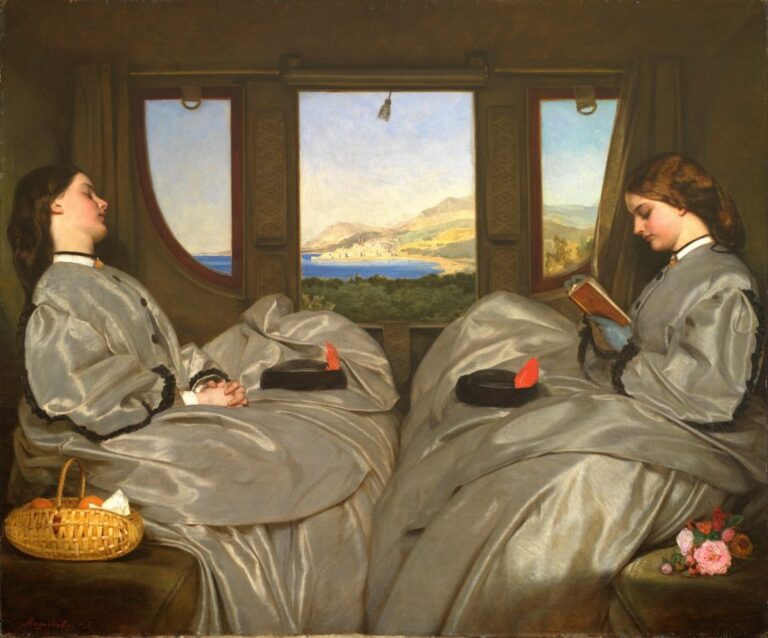
Augustus Leopold Egg, The Traveling Companions, 1862, Birmingham Museum and Art Gallery, Birmingham, UK.
Recommended
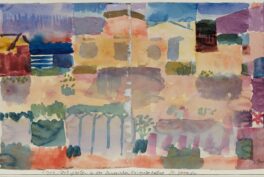
Art Travels
Artists’ Beloved Travel Destinations as Seen Through Their Art
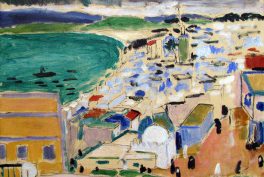
Travel in the Footsteps of Henri Matisse in Morocco
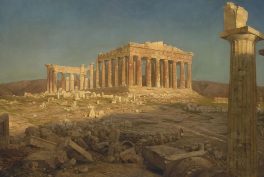
Around the World with a Painter: Frederic Edwin Church’s Travels
“ As you set out for Ithaka, hope your road is a long one,” thus begins Ithaka , the famous poem by C.P. Cavafy. When we travel, we always think about the destination – thinking of the time we spend to arrive as a hassle, a necessary evil. But, as Cavafy and many other artists will tell you, being on the road has its own kind of magic. Let us look at some of the best traveling paintings.
Traveling by Train: Traveling Companions
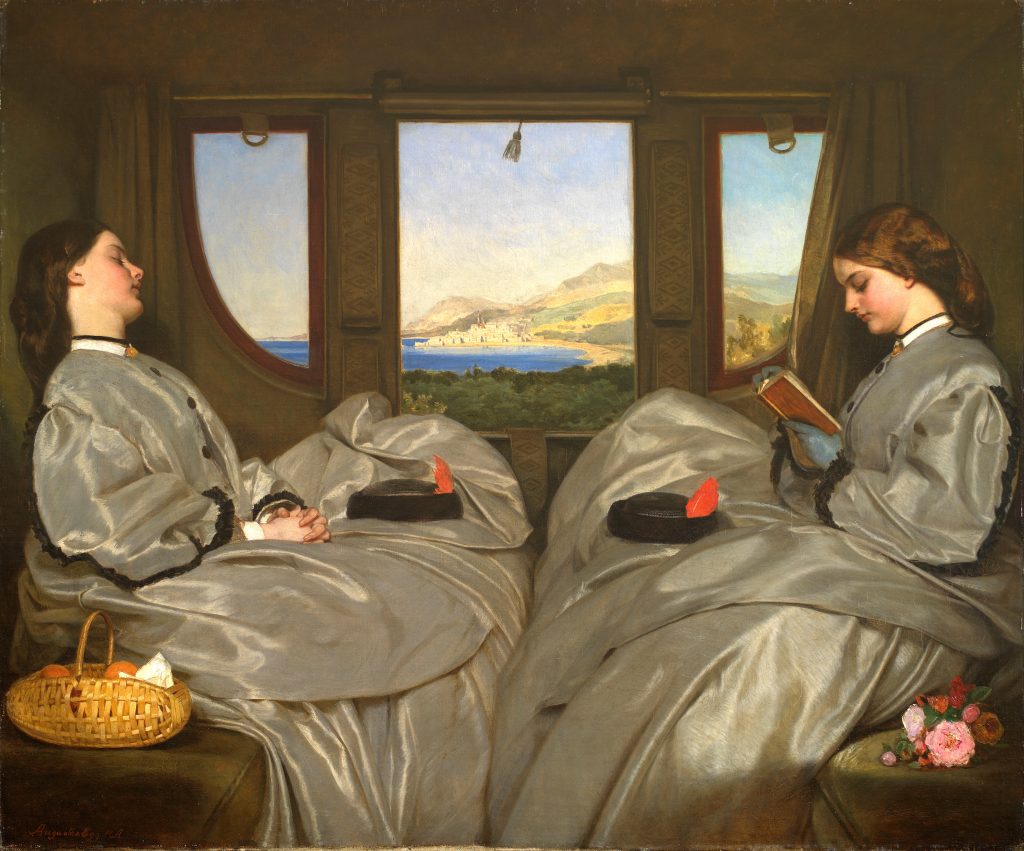
Director Wes Anderson would surely love this painting, or maybe not. At first glance, the scene inside the railway carriage looks completely symmetrical: the two women identical. They wear the same dress, the same hat, that both have placed on their lap. The window is split into three parts, emphasizing the sense of symmetry. However, there are small details that dissolve the similarity. The woman on the right has her hair up, wears gloves, and is reading a book. Beside her sits a flower bouquet, while the other with loose hair and bare hands is daydreaming, with a basket beside her.
Sadly, neither of them pays attention to the magnificent view of the French Riviera outside the window. They both remain firmly enveloped in their private worlds, eschewing the experience of traveling and thus putting an ironic ring to the painting’s title.
Traveling by Boat: Breezing Up
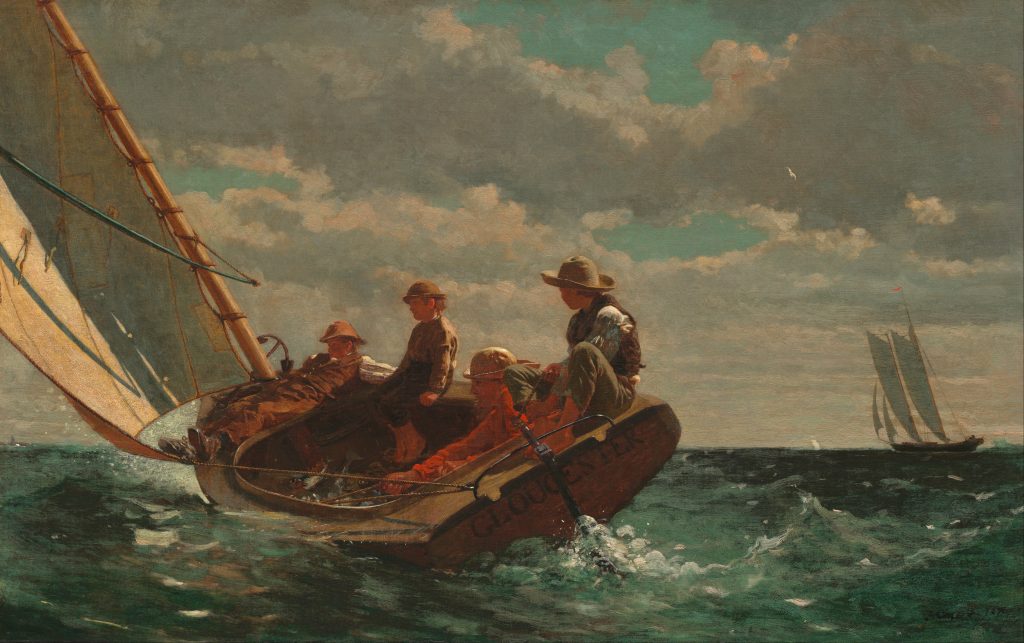
Traveling for business does not have to be boring. On a cloudy afternoon, a fisherman and three boys return from a day at sea. The boat moves quickly on the waves. The man and the boys are perched on the right side to balance the breeze that pushes the sail. It has been a good day. The floor of the boat is teeming with fish. At last, they have some time to relax. Look at the young boy in the front: he is sprawled across the bow taking in the wind and the sea.
Winslow Homer presented this painting in 1876, the centennial year of the United States. This view of American life completed the climate of postwar nostalgia at the time. Stylistically, the loose brushstrokes and warm colors remind us of the French Realism of Gustave Courbet and Edouard Manet .
Traveling by Boat: Great Wave Off Kanagawa
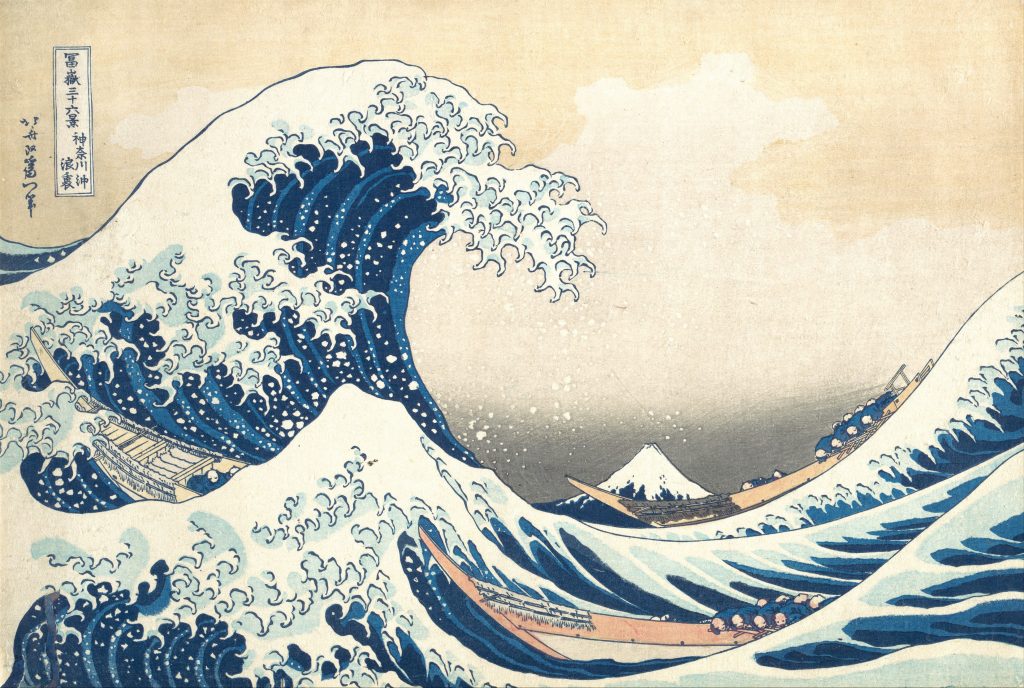
The Great Wave is probably the most famous piece of Japanese art. A huge frothing wave is about to crash on three fishing boats. The fishermen are frantically trying to get to shore – being at sea is not always fun. In the distance, the sacred mountain of Japan, Mount Fuji, is dwarfed by the immense body of water.
Katsushika Hokusai’s print is part of his series Thirty Six Views of Mount Fuji , but through the use of linear perspective, the largest mountain in Japan seems small. However, the waves are perfectly framed around it to make it stand out.
Traveling By Boat: The Last of England
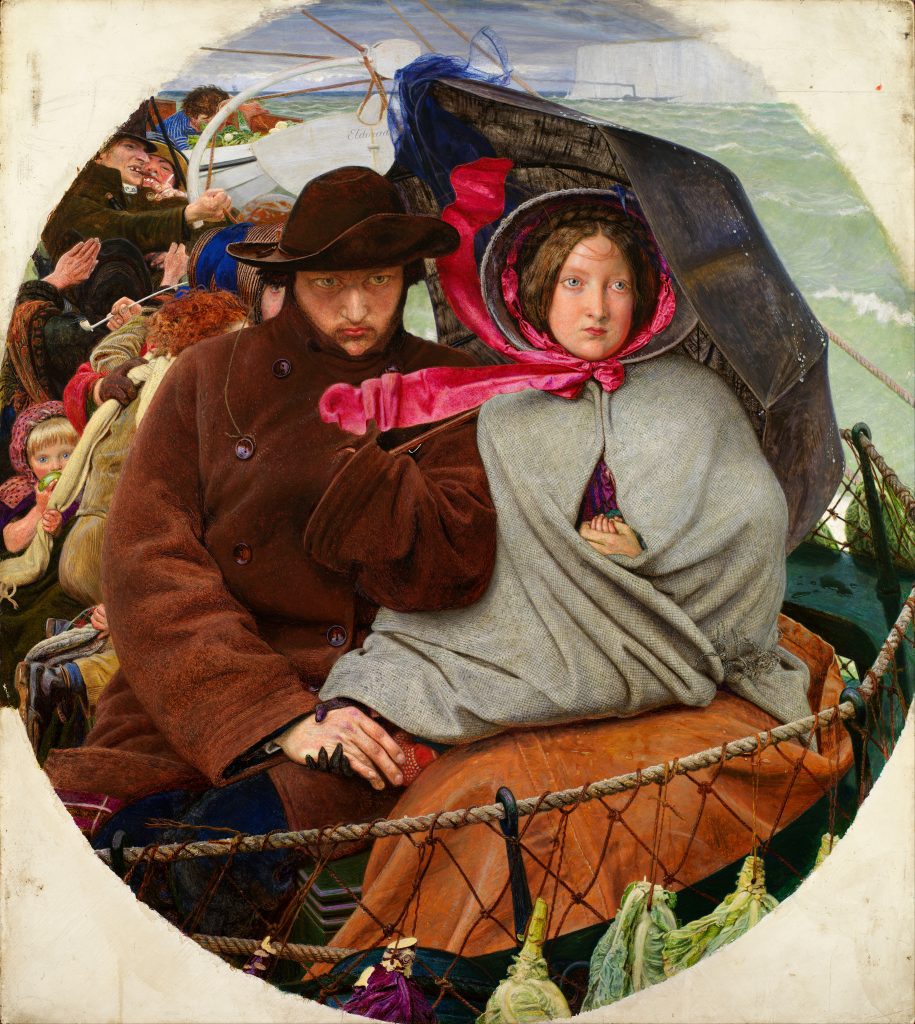
A young family sets on an uncertain journey with dreams for a new life. In The Last of England , we see a pair of immigrants beginning their voyage to Australia. The man seems broody and stressed while the woman is resigned to her fate. From an opening in her cloak, we barely see her clutching her baby’s hand. Emigration is surely one of the worst reasons to be on the road – being forced to leave everything and clinging on to hope. The white cliffs of Dover are looming in the back, the last view of England, while in front of the couple, strung cabbages reminds us of the long journey ahead.
Traveling by Car: Tamara in the Green Bugatti
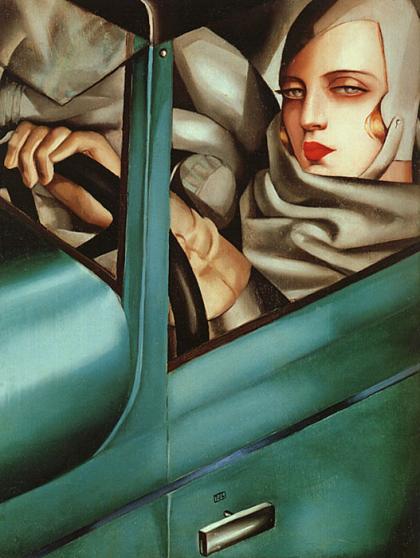
With the turn of the 20th century, traveling by car became more of a commodity than it used to be. Tamara de Lempicka , nicknamed the baroness with a paintbrush, epitomizes the modern woman of the roaring 20s. Her stylish persona, which she meticulously built, featured in all the most forward-thinking magazines in Europe.
Tamara in a Green Bugatti was a commission for the cover of the German magazine Die Dame . In her characteristic Art Deco style, the artist portrays herself as an independent, emancipated, and sexually liberated woman . She stares smugly at us, with her leather gloves and blowing majestic scarf. The car is another symbol of her emancipation. A woman driving in the 20s was a rare sight. Moreover, it is a nod to the contemporary futurist movement that celebrated speed and everything that had to do with the modern world.
Traveling by Caravan: Pilgrims Going to Mecca
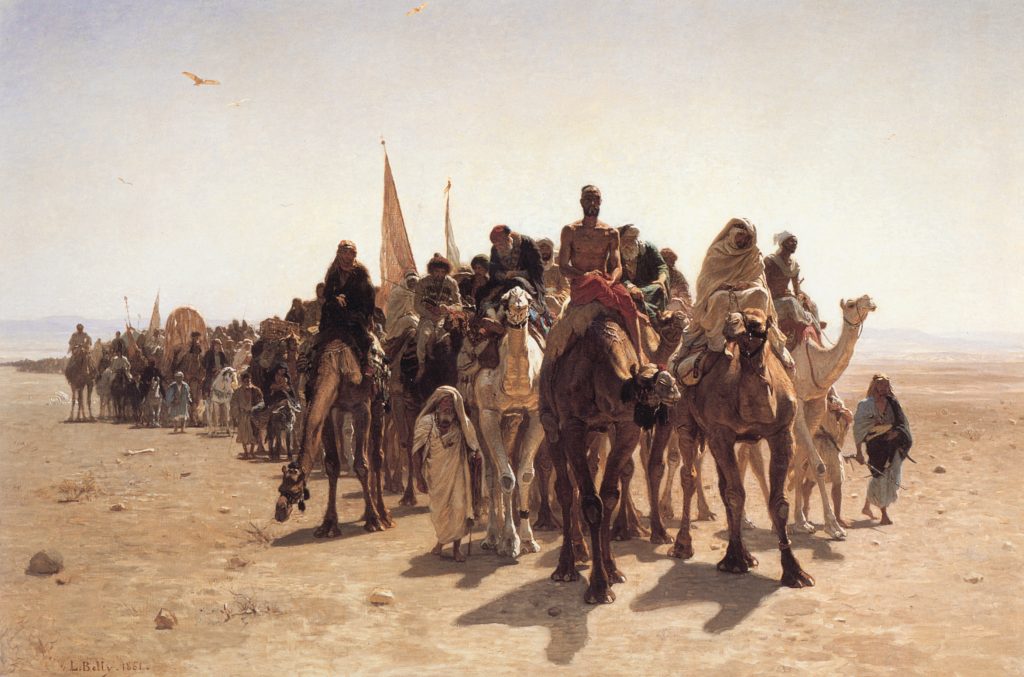
Before trains and cars, camel caravans crossed the desert to deliver goods and offer safe passage to travelers. Leon Belly’s orientalist painting shows a caravan heading towards Mecca, a place of pilgrimage for all Muslims. The convoy advances towards the viewer in a dramatic fashion.
Belly manages to capture the pious but weary faces of the pilgrims under the scorching sun. Adding an exotic note, the camels are large enough to dominate the canvas. Even though its subject matter is chiefly Islamic, Belly creates a more expansive religious meaning. Take notice to the left of the column; we can see a man walking along with a woman and child on a donkey – the pair refers to the biblical theme of The Flight into Egypt .
There are many reasons and many ways to be on the road. Whatever our destination, time spent traveling fills us with new experiences. Or, as Cavafy says, “Ithaka gave you the marvelous journey. Without her you wouldn’t have set out.”
- Augustus Leopold Egg
- Ford Madox Brown
- Katsushika Hokusai
- Tamara de Lempicka
- Winslow Homer
Get your daily dose of art
Click and follow us on Google News to stay updated all the time
We love art history and writing about it. Your support helps us to sustain DailyArt Magazine and keep it running.
DailyArt Magazine needs your support. Every contribution, however big or small, is very valuable for our future. Thanks to it, we will be able to sustain and grow the Magazine. Thank you for your help!
Anastasia Manioudaki
Art Historian, she graduated from the Department of History and Archeology of the University of Athens and has an MA in Art History from the University of Sussex. She is a member of the Association of Greek Art Historians. Her articles have been published in Ta Nea tis Technis and avopolis.gr.

5 Artsy Things to do in Tórshavn, Faroe Islands
You might find yourself wanting to travel to the Faroe Islands because you saw photographs of their spectacular bird cliffs and green mountainsides,...
Theresa Kohlbeck Jakobsen 23 May 2024
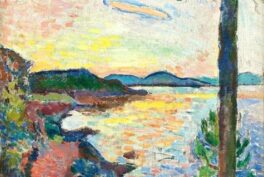
Top 5 Artsy Travel Destinations in 2024 Through Paintings
We suggest you a selection of the best tourist destinations and festivals by the hand of great artists!
Andra Patricia Ritisan 11 March 2024

Art Travels: Golden Temple of Amritsar
Nestled in the city of Amritsar in Northwestern India is the iconic Harmandir Sahib or Darbar Sahib, better known as the Golden Temple. This sublime...
Maya M. Tola 8 January 2024
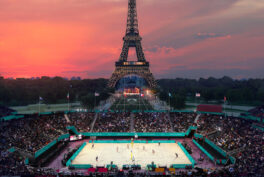
Art and Sports: En Route to the Paris 2024 Olympics
The forthcoming Paris 2024 Summer Olympics will bridge the worlds of art and sport, with equestrian competitions at the Palace of Versailles, fencing...
Ledys Chemin 9 April 2024
Never miss DailyArt Magazine's stories. Sign up and get your dose of art history delivered straight to your inbox!

- Inspiration
- Contributors
Select Page

Describing Life’s Journey and Experiences Through Art
Vanessa lemen.
Saturday, November 19th, 2016
I’ve held on and let go countless times, And the balance between the two has always found its place. I’ve found myself blindsided by what later seemed obvious, And soared high above snakes who have slithered below. I’ve scrawled out magic memories in the form of scribbles That leapt from the page and took form as a lump in my throat.
I’ve walked on tightropes with my mouth erased, And painted it onto another to speak for me.
I’ve seen faces in all of the trees around me, And heard the applause of their dry leaves when it rained.
I have floated through time, ventured in space, And walked in places it seems that time has forgotten. I’ve been lost and have lost. I’ve come back from the void To a place that was familiar but suddenly not the same. I’ve shed tears in the happiest of moments, And stood stoic in sadness, been numbed by betrayal.
I’ve stowed away life lessons in my thinking cap, And found most answers in my unconscious riffs. I’ve wandered aimlessly with beings great and small, Adventured with creatures sensitive and fierce. I’ve laughed with them in the shadows, Howled with them in the light. I’ve held signs in crowds, roared among the tribe.
In the most silent of moments, I’ve heard truth speak. I’ve hibernated for what seemed like eternity, And then awoke to shout from the mountaintops. I’ve shared strides with characters from all walks of life, And journeyed with those who defy gravity. I’ve danced with fire spirits. I’ve bonded at bonfires, Lifted by the power of human connection.
I’ve lost my breath under powerful waves, and reached the surface thankful for air.
I’ve sung with clowns and clones and wind in the branches, Flown with birds and planes and cats.
I’ve felt the heaviness of darkness, And have reached out to the most colorful of lights.
I’ve witnessed dry fields turn to flames, then black. And in those fields, I’ve run through grass tall and green again.
I’ve traveled to worlds that have only machines, And to worlds where no machines have ever existed. I’ve listened to the tales of wise monkeys, And swam in the veins of their ancestors.
I’ve grown roots and floated from limbs. I’ve seen devastation, witnessed growth and renewal. I’ve watched the sleeping breath rise and fall quietly in the chest of the ones that I love and have grown old with. I’ve been rescued and nuzzled with those whom I’ve rescued Who remind me to rest, to play, to listen and hold true. I’ve visited the spirits of those who’ve passed on, And met new souls that possess magnetic energy.
I’ve been lifted up and loved, sung harmonies on long road trips, And been comfortably quiet in shared spaces. I have fallen, I’ve been broken. I’ve risen, and I’ve healed. I have been powerful and powerless, Larger than life and microscopic. Often times, I’ve been invisible. Some adventures have been heavy, Some have been as thin as air, And most have defied the boundaries Of the years that define my lifetime.
And so I will continue to paint what life shows me…
Posted by Vanessa Lemen | Saturday, November 19th, 2016
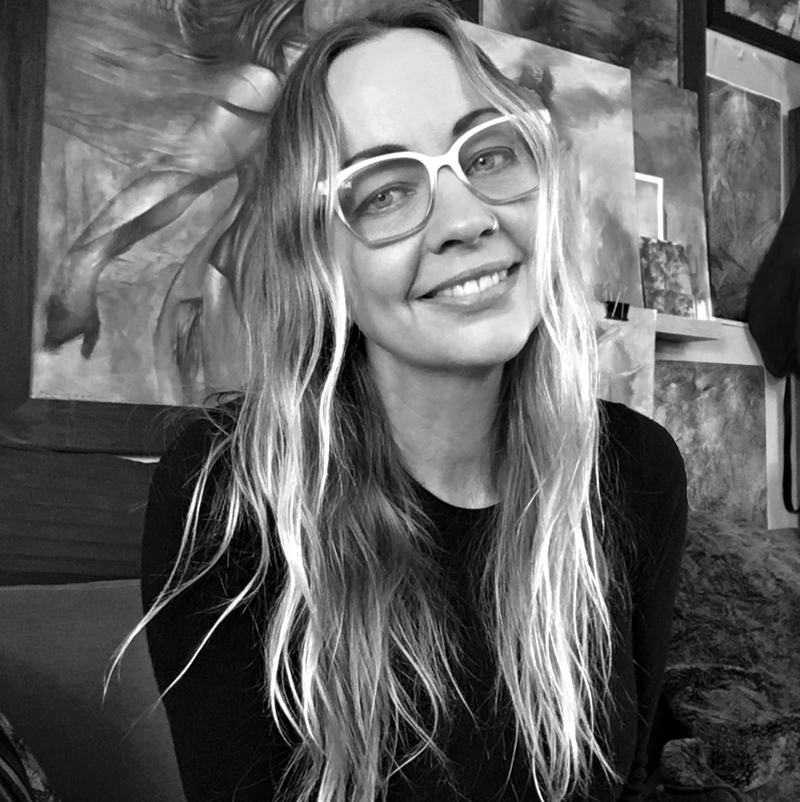
View Profile | View Posts
Vanessa Lemen is an award-winning painter based in Carlsbad, CA, with works exhibited and in private collections internationally. Her paintings are layered in subtle allegory, with an explorative process that intertwines realism and imagination to depict humanity, metaphor and story. Her work has been published in the Illustrated Limited Edition books: The Left Hand Of Darkness by Ursula K LeGuin and A Scanner Darkly by Philip K. Dick, and is published in such art books as Spectrum and Infected By Art, and has been featured in articles in magazine such as American Art Collector, ImagineFX, and Poets And Artists. Vanessa is represented by Rehs Contemporary Galleries, writes monthly columns for the Muddy Colors blog, and is an educator who mentors privately, teaches classes online, and instructs at workshops across the US. Her work has earned her The Chesley Award and other awards in publications such Infected By Art, a Spectrum Award nomination, as well as Art Renewal Center’s ARC Salon, and participation in the International ARC Salon Exhibition. Described through metaphorical imagery, it’s excerpts from her personal journey and reflection that she credits most as the inspiration for her work, and rolling with the unexpected as the very nature of her process. Much like the spontaneity of a dialogue, the marks on the surface are what evoke a response and then a discovery, and a possibility of something new to form. Each piece she creates seems to come from a chaos, and in it, she is able to create a place of reflection and curiosity, a balance of the deep-seated and the unknown, with areas of rest and of movement that intertwine to form a calm amid the chaos.
Related Posts
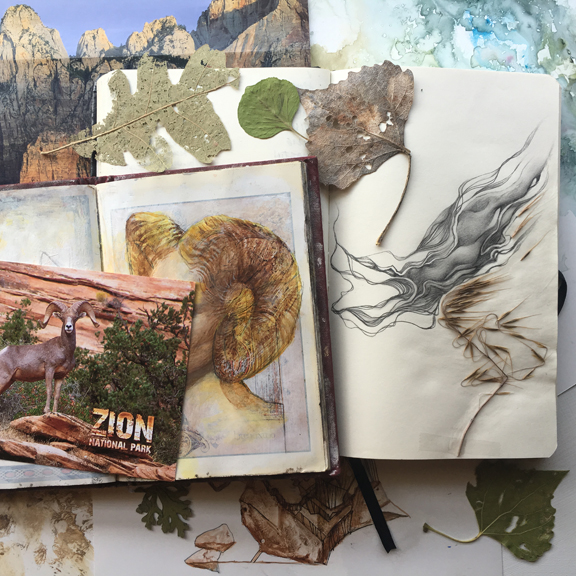
Influenced By The Environment
July 1, 2017
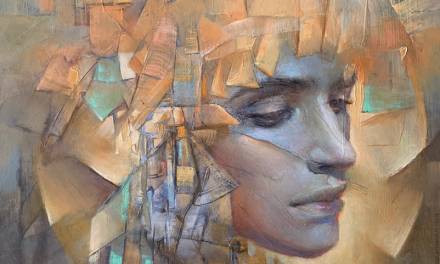
Painting Process Notes For “Dawn”
February 5, 2022
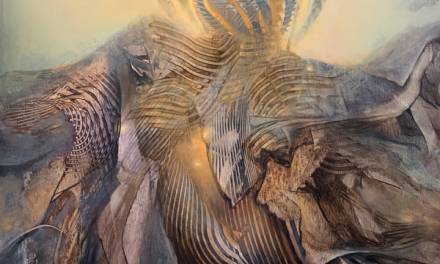
May 25, 2023
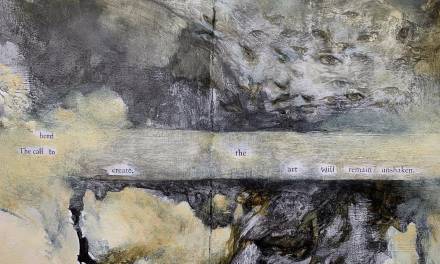
Sketchbook Affirmations
April 4, 2020
13 Comments

So much good stuff in this post! Feast for the eyes and mind.

Beautiful words and images Vanessa!!

Wow!!! Don't know what I enjoy more, the paintings or the words. Love this “I've listened to the tales of wise monkeys, And swam in the veins of their ancestors.” Swam in their veins!!!!! Excellent!

INspirador Vanessa

Beautiful…I've often thought of perhaps having a poem as my artists' bio, but not sure if that would be undertood well.
Hi David. From what I've read on MuddyColors and other 'authorities' on art portfolios / artist websites – it seems the general consensus these days is to have clear and concise information, with little to no flourish. That said, don't think it is a complete 'no go'. Cheers!

Thank you Nicolay! I'm so glad you enjoyed it!
Thank you, Brian! 🙂
Thank you! So glad to hear that you enjoyed both the words and the paintings. 🙂
So glad to hear! Thank you.
Thank you, David. Also, I'd have to concur with Nicolay on this one. Sometimes, there are certain projects, shows, or publications in which you can express yourself a bit more in a bio type of write-up, but most times those calling for a bio would like it to be clear and concise information. What I tend to do is do a bit of research on what the gallery/publication/event/website has already used for other artists – or just ask. On your own website, you can do a little of both. On my website, for example, I've posted on my About page two paragraphs that I've used in different occasions for other things. I find them both to be helpful information about me, but in different ways. You can also reserve a page for your writing, or include write-ups/poems along with your art (which I do as well, usually a couple sentences). I used to include a lot more, but always wondered if anyone even read it. More recently, I've been keeping my writing to myself.. but I'm starting to think to share it again. Anyway, thanks again, and I look forward to seeing what you might end up doing too.

Great, love the poems and paintings together. A bio really isn't the place for expressive flourishing but it needs to be put out there somewhere, as you said on your website for example. It really is an insight into you as an artist and despite talk of a painting or piece of art should stand on its own there is nothing as original as the insight of any individual artist. No one else can say it for you. BTW Vanessa, you paint some of the most graceful elegant hands. Often they are my favorite part of painting.
Trackbacks/Pingbacks
- Exploring the World of Art: A Journey Through Different Art Forms – Ask The Job - […] there are so many avenues to pursue. In this series, you will embark on a journey through different art…
Leave a reply Cancel reply
Your email address will not be published. Required fields are marked *
In Stores Now!

Materials and Methods
Featured posts, 10 things…the business of illustration, comic book coloring — part 1 of 3, studio safety, part 1 : ventilation, mental illness and artists, a fusion of imprints and oil paint, recent comments.
- Deepa singh on 15 Types of Composition This blog is so interesting and informative.
- apk on Game Mechanics And World Building With Aven Colony Thanks for sharing
- forkwen on 10 Things…I Wish I Knew Starting Out I read this directly after making a #7 mistake– lengthy email explanation of how I would fit a cover into my busy schedule when a simple “Yes, sounds…
- PM Kisan on Book Cover Trends thru Time (via DUNE) I wanted to take a moment to express my sincere appreciation for the time I spent reading your post
- 24kbet on Digital Art Is Not “Real Art” 24KBET is a premier online betting platform designed for avid sports bettors and gaming enthusiasts. It offers a comprehensive range of sports markets…
Travel and Art
Explore transport and travel through the eyes of artists
Planes, trains and automobiles
Expeditions and maps, on your bike, take a walk, artists on holiday, explore more themes, fahrelnissa zeid: city by city.
Follow the international artist’s creative journey through each of the cities she spent time in
Patricia Belli – The Scar of the Skin
Join visual artist Patricia Belli and discover what her artwork means to her
Thao Nguyen Phan – 'My reflections on the history of Vietnam, the poetry of daily life'
Step inside the studio of artist Thao Nguyen Phan and discover her mesmerising, poetic work
Sol Calero Goes Travelling in Latin America
The artist explores themes of representation and identity through colourful, immersive installations
Concorde L449-15
Hommage à chrysler corp., tram on westminster bridge, concentric bearings b, king’s cross station, london, red arrow bus, french engine, locomotive wheel, united kingdom, escaped animals, water, selected, ithaca mirror trail, ithaca, new york, the north-west passage, a journey that wasn’t, the last voyage of henry hudson, a hundred mile walk.
Travel, in the younger sort, is a part of education; in the elder, a part of experience. Francis Bacon
Lubaina Himid CBE RA Between the Two my Heart is Balanced (1991) Tate
© Lubaina Himid, courtesy the artist and Hollybush Gardens, London
B.S.A. Tour of Britain Racer Enlarged to 135%
Joseph beuys, ‘is it about a bycicle’, cycle racing, five-man pedersen (prototype no.1), michael balling up old net, outside kampala, photograph of an unidentified boy playing with bicycle parts, colour photograph of the shadow of a bicycle on the pavement, a line made by walking, performance still, the commuters, laundromat-locomotion (walking in suit), walking dream with four foot clamp, the walking man diary, marching figures.
Julian Trevelyan Canal Holidays (1975) Tate
© The estate of Julian Trevelyan
It's very important for inspiration to go elsewhere: to move away from the city into pastoral settings, and to make space for meditation. Isaac Julien
Feet on Holiday I
The last resort 40, incidents 025, black mirror, st ives beach, from the pleasure principle, study for ‘the seaside’, rio de janeiro, brazil, 1967, couple eating fish and chips, whitley bay, tyneside, photograph of mollie gordon sunbathing by the pool in puerto de la cruz, tenerife.
My favorite thing is to go where I've never been. Diane Arbus
Tracey Emin Monument Valley (Grand Scale) (1995–7) Tate
© Tracey Emin
It sometimes takes a foreigner to come and see a place and paint it. I remember someone saying they had never really noticed the palm trees here until I painted them. David Hockney
Land art or earth art is art that is made directly in the landscape, sculpting the land itself into earthworks or making structures in the landscape using natural materials such as rocks or twigs
Psychogeography
Psychogeography describes the effect of a geographical location on the emotions and behaviour of individuals
Journeys Coursework Guide
From physical journeys and migration to journeys of self-discovery, get ideas and inspiration about journeys in art
Family and Art
Uncover how artists have responded to the idea of family through art
Queer Lives and Art
Discover LGBTQ artists and queer art
Migration and Art
Explore how artists reflect on moving to new places
Black Identities and Art
Discover Black art and artists in Tate's collection
Weather and Art
Explore how artists respond to the seasons and our changing environment
Your cart is currently empty!
- Woodturning Art
- Watch Making
- Printmaking
- Photography
- Metalsmithing
- Glass / Glass Blowing
- Ceramics / Clay
- Assemblage / Collage

” Pumpkin” ORIGINAL OIL PASTEL ART Ukraine Kharkiv
FEATURED ART WORK

- How Our Site Works Fairly
- Membership Options
- How to Use Our Website
- Merchandise
- Packing and Shipping Artwork
- Guest Article Guidelines
- Frequently Asked Questions
Beginner’s Guide: Understanding & Appreciating All Art Forms
Introduction.
Art appreciation isn’t just for the elite, and it certainly doesn’t require a fine arts degree. It’s for anyone willing to open their mind and their heart to the endless possibilities that art offers. In this blog post, we’ll delve into the emotional landscape, hidden meanings, and the intricate play of colours in art. Furthermore, we’ll traverse through the grand tapestry of art history, understanding how different movements from romanticism to conceptual art have shaped our perception of the world around us.
Section 1: Engaging Emotionally with Art
Art has the power to stir our deepest emotions, transport us to different worlds, and make us question our fundamental beliefs. The first step to appreciating art is to engage with it emotionally. Try to clear your mind of preconceived notions and focus on the artwork. What do you feel when you see it? Does it bring a sense of calm or ignite a storm of feelings? Understanding your emotional response can provide the first clues to unravelling the artwork’s layers of meaning.
Remember that there are no ‘right’ or ‘wrong’ emotions. Every person’s experience with an artwork is unique and equally valid. Over time, as you continue to explore different artworks, you’ll start to see patterns in your emotional responses that can help you identify the styles, themes, or artists that resonate with you the most.

Section 2: Unearthing Hidden Meanings and Symbolism
Artworks often contain more than what meets the eye. They can be laden with symbols and allegories, each adding a new layer of meaning to the narrative. For example, in Christian art, a lamb often symbolizes Jesus Christ, while in Hindu art, a lotus represents divine beauty and purity. However, symbols can also be deeply personal to the artist, reflecting their experiences, beliefs, or aspirations.
When you encounter symbols in an artwork, take a moment to ponder their significance. Do they relate to a larger cultural or religious narrative? Do they provide insights into the artist’s life or worldview? Or do they invite you, the viewer, to imbue them with your own meanings?
Section 3: Appreciating the Use of Colour in Art
Colours can transform a simple sketch into a compelling artwork. They can set the mood, emphasize certain elements, and guide the viewer’s eye around the canvas. Artists often use colours to convey emotions or ideas. For instance, Van Gogh’s ‘Starry Night’ uses swirling blues and yellows to evoke a sense of wonder and turbulence, while Rothko’s colour field paintings use large blocks of colour to create a meditative, immersive experience.

As you explore different artworks, pay attention to their colour schemes. How do the colours interact with each other? Do they create harmony or contrast? How do they contribute to the overall mood of the artwork? By understanding the role of colour in art, you can gain deeper insights into the artist’s vision and intent.
Section 4: Understanding Art Movements: From Romanticism to Conceptual Art
Art isn’t created in a vacuum; it reflects the ideas, issues, and aesthetics of its time. By understanding the context in which an artwork was created, you can better appreciate its significance and innovation.
Romanticism : This movement emerged as a reaction against the industrial revolution and the scientific rationalization of nature. Romantic artists emphasized emotion, individualism, and the awe of nature. This movement includes artists such as J.M.W. Turner and Caspar David Friedrich, who’s works are often characterized by their dramatic landscapes and emotive content.
Realism: Emerged in the 19th century as a response to the idealized depictions of Romanticism. Realist artists sought to portray the world as it was, focusing on ordinary people and everyday scenes. They painstakingly captured the nuances of light, texture, and colour, creating works that felt almost lifelike.
Impressionism : Impressionism broke away from the detailed precision of Realism to capture the fleeting effects of light and colour. Impressionist paintings often feature visible brushstrokes, open composition, and unusual angles, giving us a sense of the world as a series of fleeting, sensory experiences.
Post-Impressionism : This movement, with artists such as Vincent van Gogh, Paul Gauguin, and Paul Cézanne, extends Impressionism while rejecting its limitations. They continued using vivid colours, often thick application of paint, and real-life subject matter, but were more inclined to emphasize geometric forms and use unnatural or arbitrary colour.
Fauvism : A style of painting in the early 20th century that emphasized vibrant, arbitrary, and non-naturalistic colour. Fauvist paintings are characterized by a spontaneous, painterly surface, and brushwork that draws attention to itself as paint on a flat surface. Henri Matisse is a well-known artist of this movement.
Expressionism : This movement prioritizes emotional and psychological experience over physical reality. Artists distorted and exaggerated forms, used vivid colours, and employed dramatic brushwork to express their inner states of mind. In Expressionist art, the emotional impact of the artwork is paramount.
Cubism : Pioneered by artists like Pablo Picasso and Georges Braque, Cubism was a revolutionary movement that challenged traditional perspectives. Instead of depicting subjects from a single viewpoint, Cubist artists portrayed them from multiple angles, creating an abstracted, geometric composition. Cubist works often seem fragmented or deconstructed, inviting the viewer to engage with the artwork in a more dynamic, active way.
Dada : This was an art movement of the European avant-garde in the early 20th century. Dadaists, like Marcel Duchamp, embraced chaos and absurdity in their work, as a reaction to the perceived nonsense and futility of World War I. Ready-made objects, sound poetry, and photomontage were common mediums in Dadaism.
Surrealism : Influenced by the theories of Sigmund Freud, Surrealism sought to explore the irrational and the subconscious. Surrealist artworks often feature dreamlike, bizarre, or even disturbing images, challenging our notions of reality. Salvador Dalí’s melting clocks and René Magritte’s bowler-hatted men are iconic examples of this movement.
Abstract Art : Abstract goes further, eschewing representational forms altogether. Instead, it uses colour, form, and line to create artworks that can be interpreted in myriad ways. To appreciate abstract art, one must let go of the need for a ‘story’ or a recognizable subject. Instead, focus on the interplay of elements and the feelings they evoke.
Pop Art : Emerging in the mid-20th century, Pop Art embraced popular culture and mass media, blurring the boundaries between ‘high’ and ‘low’ art. Pop artists like Andy Warhol and Roy Lichtenstein used bold, bright colours and often incorporated commercial images and everyday objects into their work. To appreciate Pop Art, consider the cultural context and the commentary it might be making on consumerism, celebrity culture, or the media.
Minimalism : In contrast to the expressiveness of Abstract Expressionism and the vibrancy of Pop Art, Minimalism favoured simplicity and objectivity. Minimalist artists, like Agnes Martin or Donald Judd, used basic geometric shapes, repetition, and limited colour palettes to create artworks that emphasized the purity of form. When viewing Minimalist art, consider how the artwork interacts with the space around it and how it invites contemplation through its stark simplicity.
Conceptual Art : A movement where the idea behind the work takes precedence over its aesthetic or material concerns. Conceptual artists like Sol LeWitt or Joseph Kosuth, often used photography, text, and performance to question the nature of art itself.
Remember, each art movement offers a different lens through which to view and appreciate art. Understanding the context and philosophy of these movements can enhance your art appreciation journey. In addition, each of these movements brought new perspectives and techniques to the art world, and understanding them can provide valuable context for appreciating a wide range of artworks.
Conclusion: The Journey of Art Appreciation
Art appreciation is a lifelong journey, filled with discoveries, surprises, and personal growth. Remember that it’s not about knowing everything, but about being open to new experiences and ideas. Each artwork is a new world to explore, and each viewing can reveal something new. So, immerse yourself in the world of art, and let it enrich your life in unexpected ways.
Remember : Art is not what you see, but what you make others see – Edgar Degas.
- Art History
- Artwork Feature
- Gallery News
One response to “Beginner’s Guide: Understanding & Appreciating All Art Forms”
I am not an expert in art history. I found your site because I am looking for some fundamental information about art appreciation and criticism for a class I am creating. This is a nice overview of modern art movements. However, not one female artist was mentioned in all of the descriptions. How can this still be? I suggest doing some more research and rewrite this blog entry to show that women are and have been part of the art world.
Leave a Reply Cancel reply
Your email address will not be published. Required fields are marked *
Save my name, email, and website in this browser for the next time I comment.
This site uses Akismet to reduce spam. Learn how your comment data is processed .
Get Yourself an Arts Artists Artwork T-Shirt or Coffee Mug
Contemporary artist
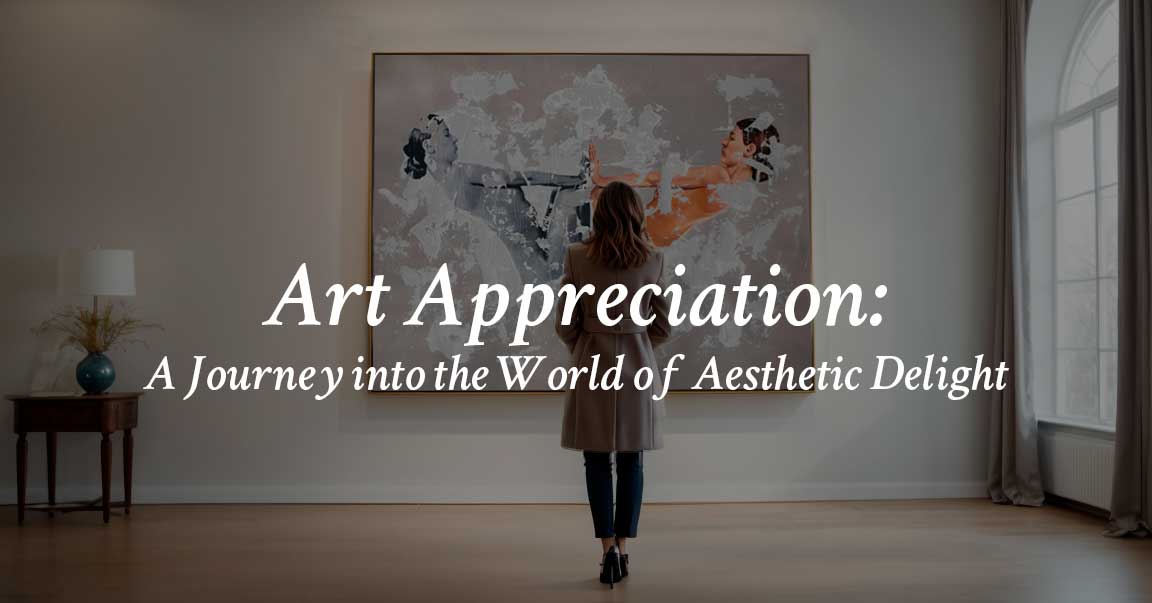
Introduction
Art has the power to evoke emotions, spark imagination, and transport us to different worlds. Art Appreciation goes beyond mere observation; it’s about developing a profound connection with artistic expression. In this article, we’ll delve into the definition of Art Appreciation, discuss its importance, and provide a roadmap for your journey into the captivating realm of art.
Definition of Art Appreciation
Art Appreciation involves more than casually glancing at a painting; it’s a process of understanding, interpreting, and valuing the artistic elements within a piece. It’s about engaging with art on a deeper level, allowing it to resonate with your emotions and thoughts.
Importance of Developing an Appreciation for Art
Why should we invest time and effort in appreciating art? The benefits extend beyond aesthetics. Art enhances creativity, cultivates critical thinking, fosters emotional intelligence, and opens doors to diverse perspectives. It’s a holistic experience that enriches our lives in profound ways.
Brief Overview of What the Article Covers
This article is your guide to unlocking the world of Art Appreciation. From understanding different art forms to developing a personal connection with art, we’ll explore practical tips and insights. Join us on this journey as we break down the barriers to art appreciation and integrate it into your daily life.
Benefits of Art Appreciation
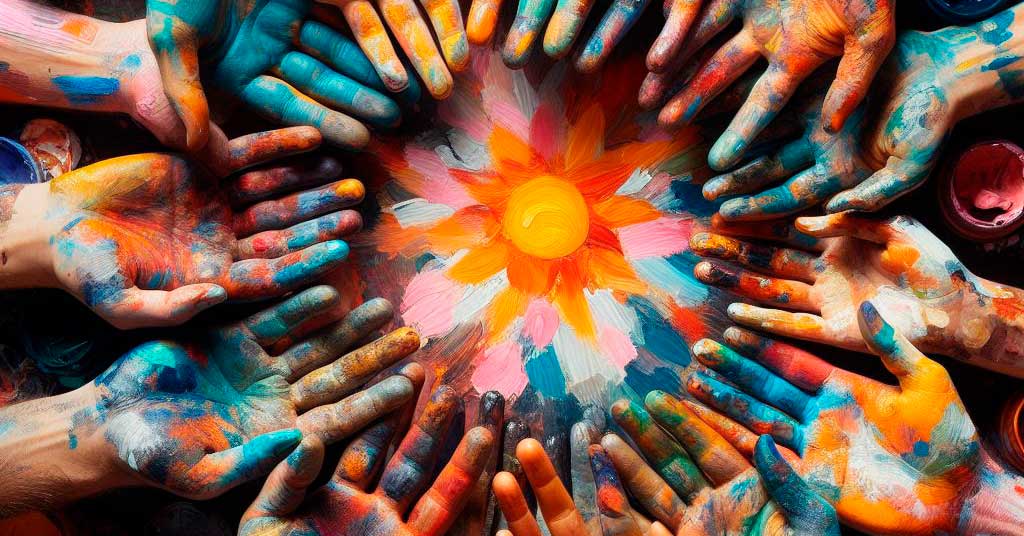

Cultivating Critical Thinking Skills
Engaging with art cultivates critical thinking skills, enabling us to analyze information effectively and form our own informed opinions. As we delve into the intricacies of artworks, we learn to identify the elements and techniques that contribute to their overall impact. This critical examination encourages us to question assumptions, challenge preconceived notions, and seek deeper understanding.
The process of interpreting art also develops our ability to evaluate evidence and draw conclusions. We weigh different perspectives, consider alternative interpretations, and assess the validity of arguments. This practice of critical thinking empowers us to make informed decisions in various aspects of our lives, from navigating complex situations to making sound choices in personal and professional endeavors.
Fostering Emotional Intelligence
Art possesses the extraordinary ability to evoke a wide spectrum of emotions, mirroring the depths of human experience and stirring our innermost feelings. Immersing ourselves in art allows us to connect with our own emotional landscape, recognizing and understanding the emotions that lie beneath the surface.
By exploring the emotional resonance of artworks, we develop empathy, the ability to understand and share the feelings of others. We gain insights into the human condition , recognizing the universal emotions that bind us together. This heightened empathy fosters compassion, enabling us to connect with others on a deeper level and build meaningful relationships.
Art appreciation also cultivates self-awareness, helping us recognize and manage our own emotions effectively. As we grapple with the emotions portrayed in art, we gain a deeper understanding of our own emotional responses. This self-awareness empowers us to manage stress, navigate difficult emotions, and build emotional resilience.
How to Start Appreciating Art
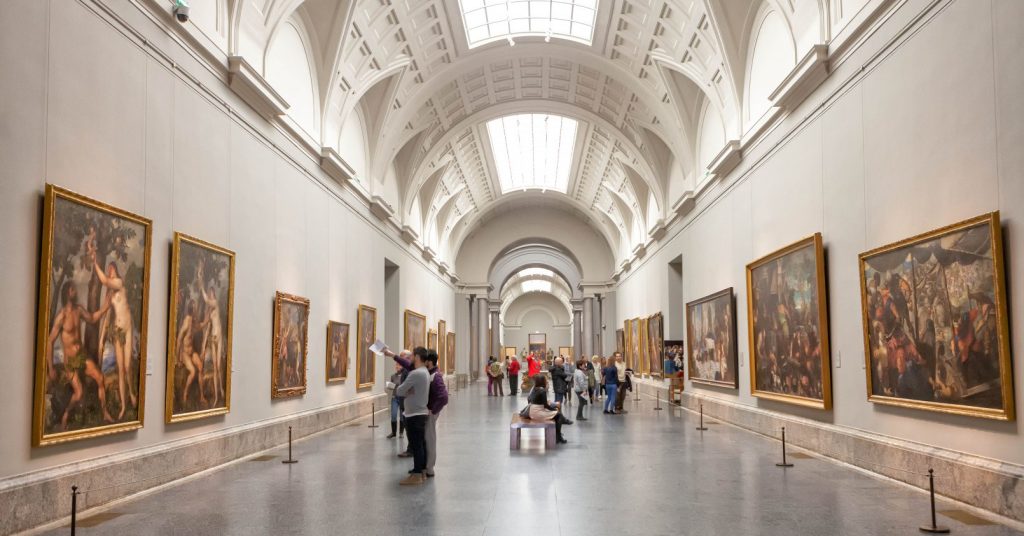
- Privacy Policy
- Strictly necessary cookies
- Third party cookies
- Cookie Policy
This website uses cookies so that we can provide you with the best possible user experience. The cookie information is stored in your browser and performs functions such as recognizing you when you return to our site or helping our team understand which sections of the site you find most interesting and useful. More about our Privacy Policy here
Strictly necessary cookies must always be enabled so that we can save your cookie setting preferences.
If you disable this cookie we will not be able to save your preferences. This means that every time you visit this website you will have to enable or disable cookies again.
This website uses Google Analytics to collect anonymous information such as the number of visitors to the site, or the most popular pages.
Leaving this cookie active allows us to improve our website.
Please enable strictly necessary cookies first so that we can save your preferences!
More information about our cookie policy
The Art of Journey

Link: theartofjourney.com


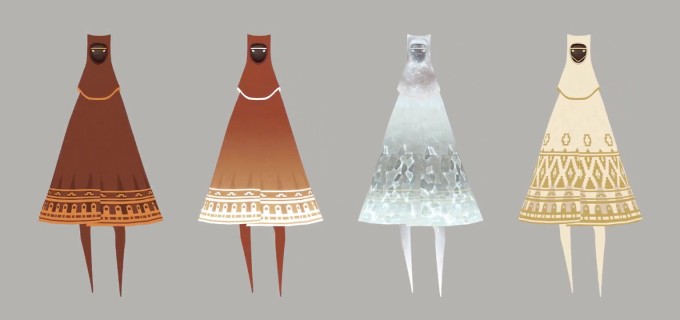
All images ©Sony Computer Entertainment America LLC.
Related Posts
The art and soul of dune: part two, the art of the creator: designs of futures past, the art of avatar the way of water.
Type above and press Enter to search. Press Esc to cancel.
Ad Blocker Enabled!
- Share full article
Advertisement
Supported by
Critic’s Pick
Julie Mehretu’s Long Journey Home
Wildfires, refugee camps and the Arab Spring might be her primary sources. But a retrospective at the Whitney affirms she is an abstract painter, first and always.

By Jason Farago
After 12 months of inactivity, now you can feel it in springtime New York: the reanimation, the flow and flux, the lives again in transit. There’s movement once more in the city, and action of high velocity at the Whitney Museum of American Art , where the roiling midcareer retrospective of Julie Mehretu has finally made it to view. It opened in November 2019 at the Los Angeles County Museum of Art , and surveys 25 years of rumbling paintings, drawings and prints. It’s arrived nearly a year late in her hometown, but her disquieted art has only grown in pertinence and power.
Mehretu came to prominence in the early 2000s for large, multilayered paintings that incorporated architectural diagrams and cityscapes. Then, about ten years ago, her art took a profound and thrilling turn — painting gestural, calligraphic abstractions, bristling with unsettled tensions that evoke the dislocations of war and the disorder of the climate. She’d won fame early. She faced a market that preferred she stick to one style. Mehretu kept moving , and in the process forged a new sort of decolonial abstraction right inside the tradition of Western art.
Meaning lies in motion. Culture never sits still. Trade, conquest, reproduction, translation, displacement, intermarriage: Art partakes of these movements, mutates en route, gets new identities as it circulates and resettles. Mehretu’s peripatetic art has all the drama of these global circulations — the flights of people and capital, the spread of viral infections and political uprisings. And this retrospective, spanning the Whitney ’s largest floor and accompanied by a spectacularly learned catalog , is a testament to how abstraction can embody multiple flows, without ever settling down, and open new vistas of freedom.
Mehretu was born in 1970 in Addis Ababa, to an Ethiopian father and an American mother. They immigrated to Michigan later that decade, after the military junta known as the Derg began a campaign of terror. While studying at the Rhode Island School of Design, she made maps and charts that suggested some kind of demographic analysis, but whose dashes and squiggles never disclosed what was being graphed.
Two intriguing pencil drawings here, both titled “Migration Direction Map” and dating to 1996, comprise dozens of cells and circles overlaid with arrows in all directions. What’s migrating? Birds, people, illegal weapons? All and none of them. What Mehretu was beginning to picture were the dynamics of systems on the move.
She came to New York at millennium’s end, taking up an artist’s residency at the Studio Museum in Harlem. Her work grew larger, more architectural and more explicitly occupied with mapmaking and urbanism. Lines accreted in an essentially radial configuration, with large arcs orbiting an absent central axis, and orthogonal spokes sprouting from the core.
Street plans of African capitals, or wire frames of housing blocks and highways, commingled with sweeping curves and vivacious scratches. Rectangles and diamonds overlaid the compositions like flags at a stadium, or signs at an airport terminal. In places she interpolated cartoonish clouds and explosions.
Ambitious, intricate and proudly global, these dense paintings and drawings made Mehretu the breakout star of a maverick Harlem gallery called the Project , and a standout in “ Freestyle ,” the Studio Museum’s hotly debated 2001 show of “post-Black art.”
Now, at 20 years’ distance, I’ve got to say that the early works look pretty mannered. The overelaborate surfaces seem to evoke globalization as a simple excess. Many seem like remnants from a circa-2000 vogue for recondite, inscrutable maps and diagrams, produced by artists like Matthew Ritchie , Mark Lombardi and Franz Ackermann.
But spending time with them again, I still appreciated the seriousness with which she built a whole painterly language (she wasn’t even 30 at the start), and how she engaged with hybridity, diaspora and violence without leaving the terrain of abstract painting. She did this above all through an innovative layering technique, revealed at the Whitney in two films of her in the studio, shot by her friend, the artist Tacita Dean . Mehretu usually began by drawing wire-frame outlines across the whole canvas, which she then shellacked with a clear acrylic layer that would be sanded down to create a new painterly surface. She’d repeat the process three or four times, saturating each layer with radial lines and geometric shapes. You get a vertiginous sense of depth — as if the one-point perspective of Renaissance painting had collapsed, from a “window on the world” into a whirlwind of motion and migration.
It took some time, but around 2011 — triggered, significantly, by the Arab Spring, which seemed so hopeful that year — Mehretu started to push into new territory. First in her tremendous panorama “ Invisible Line ,” and then in the dramatic “ Mogamma ” quartet, she eliminated the orbital axis that structured her early works. She instead overlaid wire-frame drawings of New York, Cairo and Addis Ababa with forests of short, sharp, freely drawn lines, made with a watery black sumi ink used in East Asian calligraphy.
Now freed of the early paintings’ strict radial structure, the countless watery marks coagulated into swarms, which seemed to be blowing from one corner of the painting to the other. The marks were bodies in Tahrir Square, or seized-up financial markets. They were murders of crows; they were clouds of tear gas.
She was painting current crises as a bodily experience, free from the obligations of narration, and as she did so she grew confident enough to let the architecture disappear. The pictures got darker, more tremulous. The marks got bolder, more corporeal; even her own handprint appeared. In the breakthrough series “ Invisible Sun ” (2014), longer and more calligraphic black lines mustered into raven-like migrations, flocking through evocative gray erasures. (The Mehretu black line is a thing of wonder, as confident and unmistakable as Schiele’s trembling contours.) It’s as if she discovered, after years translating cities and buildings into abstract form, that whole urban systems were already embedded inside her strokes.
There’s something dramatic in how this show, curated by Christine Y. Kim of Lacma with Rujeko Hockley of the Whitney, builds to the abstractions of the last seven years. Now the backgrounds begin as JPGs from news websites — catastrophic pictures, of riots or wildfires or refugee camps — that are blurred to illegibility in Photoshop. She covers these turbid, hot-colored grounds with those deft black lines and smudges, plus airbrushed spumes of white or red, and also multicolored halftone dots that form a bridge between image and information.
No less invested in movement and mixing than the early work, these churning new paintings present much more volatility. The clean, centripetal choreography that once stood for the global has given way to contaminated streams and surges. And their deep layering of printed, stenciled and handmade marks suggests how data, as much as ink, can be a painterly tool. That’s a concern she shares with numerous abstract painters, such as Jacqueline Humphries or Keltie Ferris , and one that builds on the explorations of Jack Whitten and Albert Oehlen , who both translated brush strokes back and forth between the canvas and digital tools (Whitten with a Xerox machine, Oehlen with an early laptop).
The Whitney’s wall texts lean hard on Mehretu’s hidden source material, disclosing that this one began with a document of ethnic cleansing, that one with a white-supremacist demonstration. They aren’t “about” riots or wildfires, though, any more than Monet’s haystacks are “about” farm feed, and they shouldn’t be treated as a game of Magic Eye. They are abstract paintings, first and always . Their force and furor derive from uncountable inputs, and in these paintings the burning Grenfell Tower and the gestures of Chinese calligraphy can’t be easily sundered.
It may sound strange, but for all her success, and all the attention to her cosmopolitan sources, Mehretu has been consistently underestimated as an abstract painter. Her achievement passes not only through urbanism and protest, but through acrylic, ink, spray guns, tracing paper. Yet in the catalog, the artist justifiably grouses that “my work was largely left out of conversations about abstraction, out of ‘ Painting 2.0 ,’ out of the dialogue with other abstract painters, even outside the story of queer abstraction.”
Even as her art has sold for millions at auction, she has had to contend with the minimizations that attend certain artists. We still afford full creative freedom, and a full reckoning with images and ideas, first to the unmarked artist (white, male, straight, native — none of which get designated as an “identity”). The marked artist (Black, female, queer, immigrant) usually gets a lesser job, tasked by our museums and collectors to deliver cheery uplift of her assigned group, or digestible criticism of previous wrongs.
If the Whitney retrospective has one value above all, especially for young artists, it’s Mehretu’s absolute refusal to accept a role so reduced. The new paintings reveal their workings more slowly than before. They’re more haunted, and far more difficult. Their mass overpowers all attempts to fix the artist’s own position within some neocolonial matrix. They demand attention to form, and long minutes of looking. And even then — here is their pleasure, and their political potency — they will not give up all their secrets.
Julie Mehretu
Through Aug. 8 at the Whitney Museum of American Art, 99 Gansevoort Street, Manhattan. 212-570-3600; whitney.org . Advance tickets required.
Jason Farago, critic at large for The Times, writes about art and culture in the U.S. and abroad. In 2017 he was awarded the inaugural Rabkin Prize for art criticism. More about Jason Farago
Art and Museums in New York City
A guide to the shows, exhibitions and artists shaping the city’s cultural landscape..
Pieces add up to an archive of a life lived deeply in Lyle Ashton Harris’s compelling survey at the Queens Museum.
The photographer Vivian Maier was a supremely gifted chameleon. But even in her striking new exhibition at Fotografiska , she remains in the shadows.
Ray Johnson, the artist you meet in a small, revelatory show, is quite different from the one known for mail art and his later gritty samplings of popular culture.
At the Museum of Modern Art, the documentary photographer LaToya Ruby Frazier honors those who turn their energies to a social good .
Looking for more art in the city? Here are the gallery shows not to miss in July .
- Explore Art + Culture
Site Search
The collections and archives.
Looking for an object or work of art?
Looking for archival materials?
Journey of Color

May 4, 2023–April 4, 2024
Freer Gallery of Art | throughout the building
Collection Area
American Art, Ancient Egyptian Art, Ancient Near Eastern Art, Arts of the Islamic World, Biblical Manuscripts, Chinese Art, Japanese Art, Korean Art, South Asian & Himalayan Art, Southeast Asian Art
Color draws attention, conveys important visual clues, and elicits emotions. At the same time, the perception of color is subjective, and understandings of its meanings and functions are not universal. A color may represent happiness and hope in one culture but anger and destruction in another. One culture may refer to a certain color as observable in nature, while another may not even have a name for it. Color perception can vary not only across cultures but also from person to person.
Whether pulverizing gold, crushing lapis lazuli, or grinding cochineal insects, artists across Asia have experimented for millennia with a wealth of minerals, bugs, and plants to create eye-catching pigments. Knowledge of substances and techniques traveled across regions and was developed by different communities in innovative ways. Join us on a Journey of Color as we highlight thirty-four objects that reveal how different cultures obtained, produced, and used color to individualize their creations and tell layered, universal stories.
Look for the orange “Journey of Color” bar on select labels throughout the galleries to learn more.
Journey of Color is part of the 2023 programming marking the 100th anniversary of the National Museum of Asian Art’s founding. Learn more about our centennial celebrations . #TheNext100
Explore Art Stories

1050 Independence Ave. SW Washington, DC 20013 202.633.1000
© 2024 Smithsonian Institution
- Terms of Use
We’re fighting to restore access to 500,000+ books in court this week. Join us!
Internet Archive Audio

- This Just In
- Grateful Dead
- Old Time Radio
- 78 RPMs and Cylinder Recordings
- Audio Books & Poetry
- Computers, Technology and Science
- Music, Arts & Culture
- News & Public Affairs
- Spirituality & Religion
- Radio News Archive

- Flickr Commons
- Occupy Wall Street Flickr
- NASA Images
- Solar System Collection
- Ames Research Center

- All Software
- Old School Emulation
- MS-DOS Games
- Historical Software
- Classic PC Games
- Software Library
- Kodi Archive and Support File
- Vintage Software
- CD-ROM Software
- CD-ROM Software Library
- Software Sites
- Tucows Software Library
- Shareware CD-ROMs
- Software Capsules Compilation
- CD-ROM Images
- ZX Spectrum
- DOOM Level CD

- Smithsonian Libraries
- FEDLINK (US)
- Lincoln Collection
- American Libraries
- Canadian Libraries
- Universal Library
- Project Gutenberg
- Children's Library
- Biodiversity Heritage Library
- Books by Language
- Additional Collections

- Prelinger Archives
- Democracy Now!
- Occupy Wall Street
- TV NSA Clip Library
- Animation & Cartoons
- Arts & Music
- Computers & Technology
- Cultural & Academic Films
- Ephemeral Films
- Sports Videos
- Videogame Videos
- Youth Media
Search the history of over 866 billion web pages on the Internet.
Mobile Apps
- Wayback Machine (iOS)
- Wayback Machine (Android)
Browser Extensions
Archive-it subscription.
- Explore the Collections
- Build Collections
Save Page Now
Capture a web page as it appears now for use as a trusted citation in the future.
Please enter a valid web address
- Donate Donate icon An illustration of a heart shape
The Art of Journey
Item preview.

Share or Embed This Item
Flag this item for.
- Graphic Violence
- Explicit Sexual Content
- Hate Speech
- Misinformation/Disinformation
- Marketing/Phishing/Advertising
- Misleading/Inaccurate/Missing Metadata
plus-circle Add Review comment Reviews
1,064 Views
20 Favorites
DOWNLOAD OPTIONS
In collections.
Uploaded by scanuki on December 22, 2023
SIMILAR ITEMS (based on metadata)
[ Skip to content ] [ Skip to main navigation ] [ Skip to quick links ] [ Go to accessibility information ]
Eight artists looking at experiences of migration
Posted 28 Sep 2020, by Ashley Tan
Around the world, border closures and national lockdowns have meant that the movement of people has largely ground to a halt. But for many refugees and asylum seekers, displaced by war, famine, and persecution, staying still is not an option. They are forced to make dangerous journeys until they are able to seek refuge in safer lands. In recent months we've seen some of these journeys captured in shocking detail on the news. The media has cast its collective eye on attempts to cross the Channel – usually on dangerously crowded dinghies – and has turned the act of migration into a politically charged discussion of rights.
View this post on Instagram A post shared by Banksy (@banksy) on Aug 29, 2020 at 3:56am PDT
The ongoing migration crisis compelled art provocateur and activist Banksy to fund and launch a search-and-rescue boat, named the Louise Michel , into the Mediterranean sea. Named after the nineteenth-century French anarchist, the bright pink boat features the artist's signature stencils, and acts in equal parts as art, political statement, and rescue operation: it brings attention to the dire situation faced by migrants at sea, while serving as a searing response to European governments' inaction to the crisis.
Banksy's intervention leads us to consider the visual representations of migration in a politically fraught atmosphere. The concept of migration has been overwhelmingly represented in the public discourse, largely through graphic means. Harrowing recounts by survivors, as well as video evidence of detention, deportation, and drownings have made front-page news, and been the subject of numerous documentaries and works of art.
Indeed, the incredible odds stacked against migrants in their decision to flee life-threatening situations – in search of safety and a better life – makes their stories both urgent and important to tell. Below are eight works by artists who sought to capture the different moods, experiences and subjectivities of migration.
Eve Goldsmith Coxeter
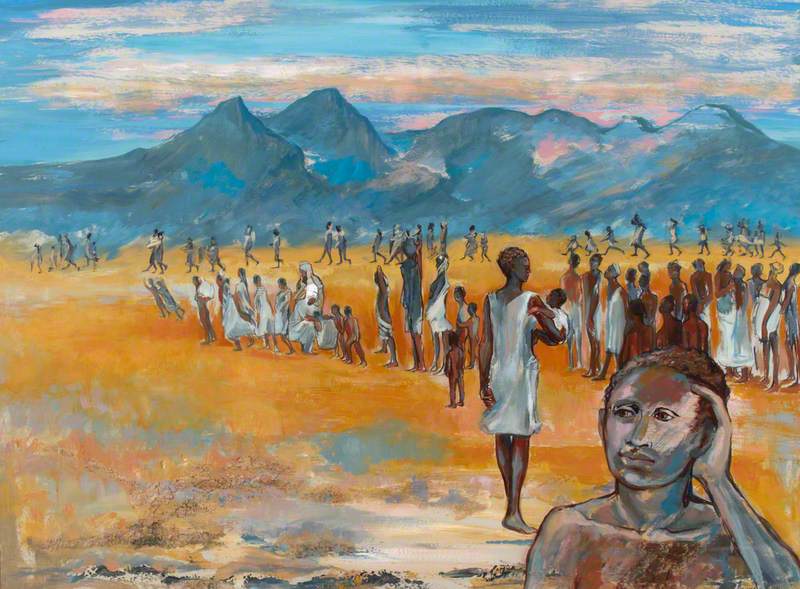
Is Famine Ever Permissible? Compulsory Migration Ethiopia 1991
Eve Goldsmith Coxeter (b.1928)
Part of the British Red Cross Museum collection, Eve Goldsmith Coxeter 's Is Famine Ever Permissible? Compulsory Migration Ethiopia (1991) illustrates the journey endured by Iraqi Kurds as a result of expulsion from the country during the Gulf War. The tragic circumstances laid bare — the rising streaks of heat in the unforgiving climate, as they endlessly march across the desert in search of a safe haven – suggest that the answer to the titular question may be obvious.
Yto Barrada
![journey of artworks Dormeurs [The Sleepers] Tangier, Fig. 2](https://d3d00swyhr67nd.cloudfront.net/w800h800/collection/BST/BMAGG/BST_BMAGG_K6306-001.jpg)
Dormeurs [The Sleepers] Tangier, Fig. 2 2006
Yto Barrada (b.1971)
In Yto Barrada 's photographic series Dormeur [The Sleepers] Tangier (2006), the perils of migration are exposed in the bustling setting of a city park. The sleepers have been photographed faceless and motionless, curled up in vulnerable positions as they await passage across the Strait of Gibraltar in search of better employment prospects in Europe.
These poses darkly mirror what could very well be their fate on the seas in the perilous journey. They reveal that in everyday, public spaces, lives may be in limbo, and that to live 'in the present' is a privilege and luxury that is not afforded to everyone.
John Watson Nicol

Lochaber No More 1883
John Watson Nicol (1856–1926)
The passengers in John Watson Nicol 's Lochaber No More (1883) are disconsolate and rueful, their contemplation stretching far beyond the seas they travel on. Their worldly possessions are assembled close to them on the ship's deck. As migrants make long and arduous journeys, they must travel light and pack items they deem most significant to them.
As the Highland Clearances drove a large number of people out of northern Scotland, the title 'Lochaber No More' refers to their forced separation from a place they have known forever. Like his father before him, Nicol was a vocal activist for Highland inhabitants and painted many of them in situations of plight.
Most recently, the Colombian-born artist Oscar Murillo used the work as a centrepiece for his installation at the 2019 Turner Contemporary in order to highlight how migration is not a practice that should be delegated to the 'other', or be seen as exotic.
Liam Belton
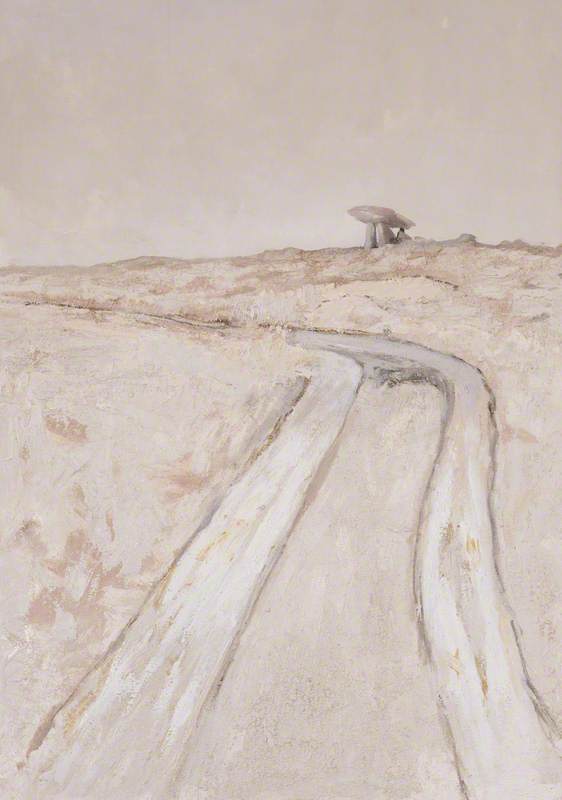
Kilclooney Dolmen, Donegal 2003
Liam Belton (b.1947)
Given the long history of migration in the North Atlantic Ocean, it comes as no surprise that the Art UK database is rich with works dedicated to the passage of people between Scotland and Ireland. Referencing the movement of people between the two countries during the Mesolithic and Neolithic eras, Liam Belton 's Kilclooney Dolmen, Donegal (2003) depicts a dolmen – or prehistoric tomb – atop a hill in Kilclooney, that is older than the pyramids of Giza. It reminds us that migration and the movement of people is not a recent phenomenon.
This work currently features in the Scottish Parliament, a testament to the political acknowledgement of migration's lasting impact on the country. A similar work by Margaret Leathart exists in the Northern Ireland Civil Service collection.
Mike McDonnell
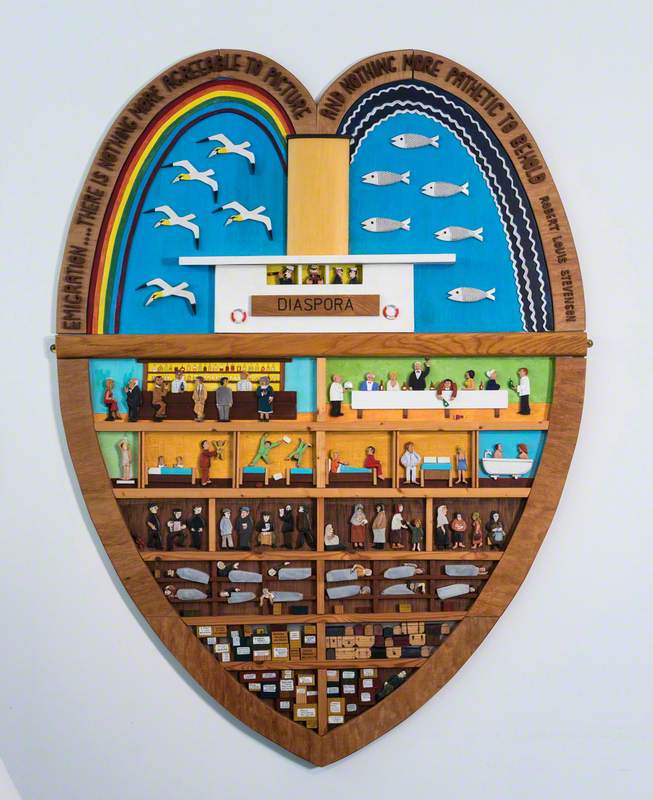
A Ship Named 'Diaspora' 2007
Mike McDonnell (b.1939)
In Mike McDonnell 's A Ship Named 'Diaspora' (2007), beneath a seemingly harmonious, or at least blissfully ignorant façade, the amiably cartoonish passengers reveal an uncomfortable reality. They journey together in the heart-shaped confines, but as the levels of the ship descend it becomes clear that passengers are divided based on privilege that reveals itself in race, religion, and class. McDonnell depicts a scathing commentary on how outwardly multicultural societies continue to insidiously practice segregation.
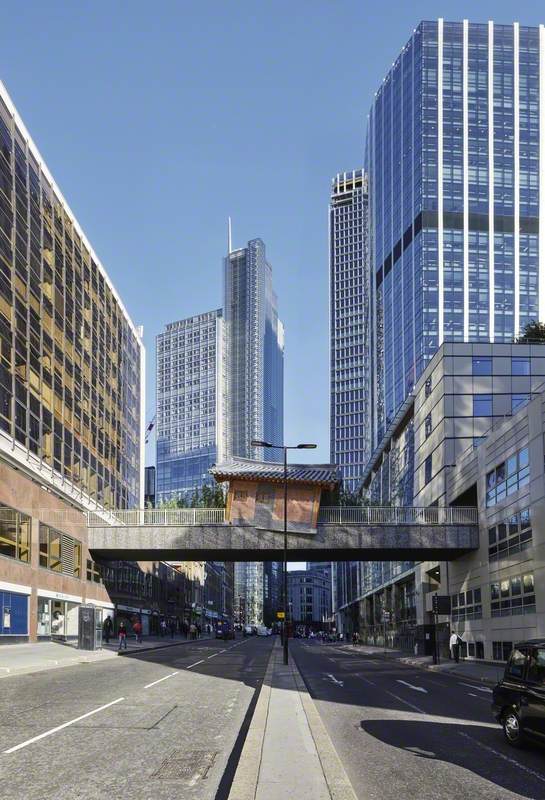
Bridging Home, London 2018
Do Ho Suh (b.1962)
Do Ho Suh 's Bridging Home, London (2018) illustrates the discordance a new inhabitant may feel in a place they still deem foreign, or where they are seen as such. On a busy street in Central London, a lopsided replica of Suh's traditional Korean childhood home sits incongruously with the skyscrapers towering over it, as if parachuted onto the path it sits on. Culture shock sets in as, unfamiliar with the values and mores of a new setting, some face a struggle to fit into a wildly different new society.

Woman in Grief 1968
Uzo Egonu (1931–1996)
Migration does not mean losing your sense of cultural identity. Far from that, it means fusing new identities together. Synthesising numerous motifs and experiences on a painted canvas is Uzo Egonu 's way of keeping the various facets of his multicultural identity intact.
In Woman in Grief (1968), Egonu uses the canvas to navigate the identity he has weaved between Nigeria and the United Kingdom. Conceived during the Nigerian Battles of Onitsha, the work was developed by Egonu as a means of personal connection with, and concern for his family in the war-torn region.

The Hand Made Map of the World 2013
Tam Joseph (b.1947)
What is thinking about migration without considering the borders that migrants have to pass through? Tam Joseph 's The Hand Made Map of the World (2013) reinterprets the navigational tool in an act of radical boundary-blurring and urges us to consider the harmful geopolitics of borders.
'People cross borders. / It's been that way ever since / borders crossed people,' writes Antoine Cassar in his 8 no-border haiku, and as we explore the new narratives that can emerge from Joseph's exercise of border-swapping, we realise that much of the histories of these perimeters are rooted in dispute and war.
These works mark different points in each individual's complex journey of separation, waiting, and longing. Whether depicting a scene of tragedy or as an expression of personal anguish, beneath the exterior of migration-themed art often lies an urgent call to action. These works resonate with this moment of crisis, and urge us to act.
Ashley Tan, freelance writer
- Share on Facebook
- Share on Twitter
More stories

Learning resources
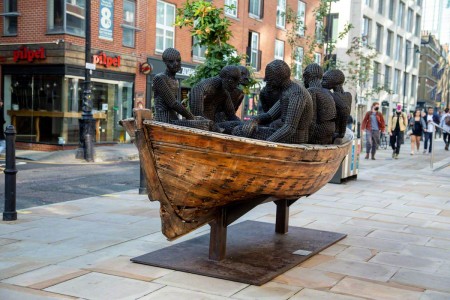
- About Nancy
- Speaking & Teaching
- Student Login

Trust Yourself
& ignite your creativity, to create your deepest art with confidence..

It’s time to express the elusive, deepest art
You yearn to create..
Now is the time to say Yes!
Start Painting in 2024!
Choose your course.
Which program is right for you
Depends on where you are in your Artistic Journey and where you want to be
Create Abstract Paintings
Explore Your Own Personal Lexicon Of Mark Making With Powerful Exercises

Activating The Canvas™
A self-paced 5 module online course to free up your inner artist in this exciting introduction to abstract painting.
Activating the Canvas was featured As One of the Top Online Art Courses by CreativeBloq.com
Trust Yourself In Your Art
The Inner Journey to believe in yourself & 2 technical game changers to create with confidence
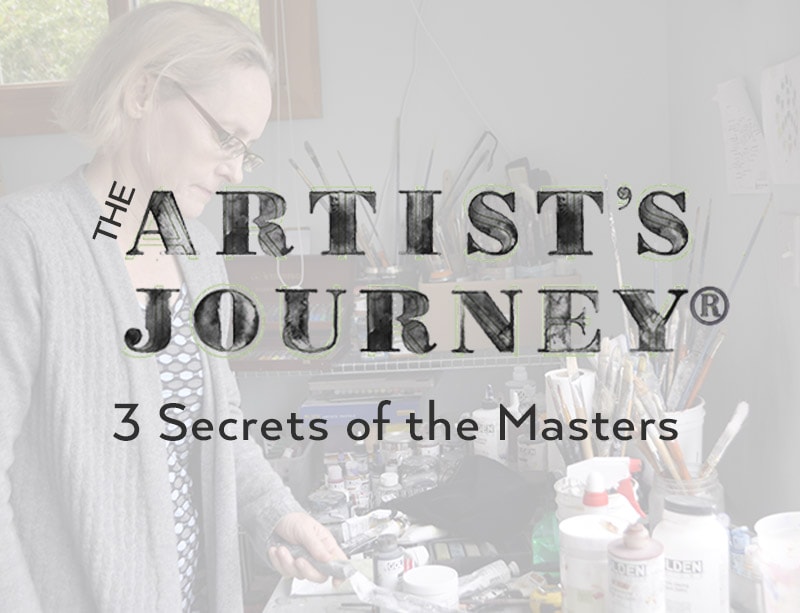
The Artist’s Journey®: 3 Secrets of the Masters
A self-paced 5 Module online course where you’ll learn to believe and trust in yourself, so you can create art with confidence, deeply explore and experiment, and embrace the unknown.
Simplify Color
Explore & Experiment with color with ease and joy. Simplify & create dynamic color combinations

Experimenting With Color™
A self-paced 6 module online course that simplifies the complexity of color. Develop a deeper knowledge and confidence when you employ color in your paintings. Create dynamic, visually exciting color combinations with ease. .

The Artist’s Journey®:
Bold strokes to spark creativity.
Whether you dream of loosening up and exploring creativity, expressing yourself, healing and becoming whole, experimenting with paints, colors, and techniques, or surprising yourself with your art, The Artist’s Journey® is your step-by-step guide to bold self-expression .

Creativity Reflection Journal
Creativity is central to feeling alive. Unleash your inner artist.
Spark your imagination in The Artist’s Journey Creativity Reflection Journal with creativity prompts, poetic musings and stories inviting you to reflect on and activate the inner sources of your creativity.

The Adjacent Possible:
Evolve your art. from blank canvas to prolific artist.
Discover the science of creativity and the art of the possible- the adjacent possible!
Take your art to the edge of creation and collapse- to the place of poised instability where your paintings evolve. Step into the unknown, access The Adjacent Possible and create art that surprises and wows you.

Guidebook & Stories Of Artistic Transformation
Animating the science of creativity and the art of the possible with concepts and artists’ stories embracing the unfolding of their art.
Step into the unknown and exolore the art of the possible in your art. This book connects scientific concepts with artistic practice to understand the nature of surprise. Artist’s stories bring alive the concepts of the adjacent possible.

A young psychiatrist with a photographic memory, psychic abilities, and a heart of gold. An unlocked Psych Ward where stories of love, loss, trauma, hope, and redemption unfold. Tune in for weekly episodes of Dr. Scarlett Youngjoy’s adventures at the renowned Harford Hospital, and vote for your favorite character in Dr. Scarlett’s care. This is a work of fiction. Names, characters, places and incidents either are the product of the authors imaginations or are used fictitiously.
ABOUT NANCY
Artist, best-selling author, and Stanford educated existential psychiatrist, Dr. Nancy Hillis guides and inspires you as you step into the terra incognita of your soul and face your vulnerability as an artist. She believes that your most astonishing work comes from deep exploration and experimentation. Nancy encourages you to find the nascent, unexpressed parts of yourself, give voice to your subconscious experiences, and finally express YOU in your art and life.
Founder of The Artist’s Journey® and The Adjacent Possible® workshops and courses, Nancy has led over 50,000 students on their creative journeys. Not only does Nancy encourage you to express yourself in your art, she has created courses and workshops to guide you on a tangible and accessible path to your deepest artistic fulfillment.

~ Vera V. Tchikovani, San Francisco, CA, Artist’s Journey® Course Alumna

Teresa has experienced a turning point in her art

~ Teresa Pisani
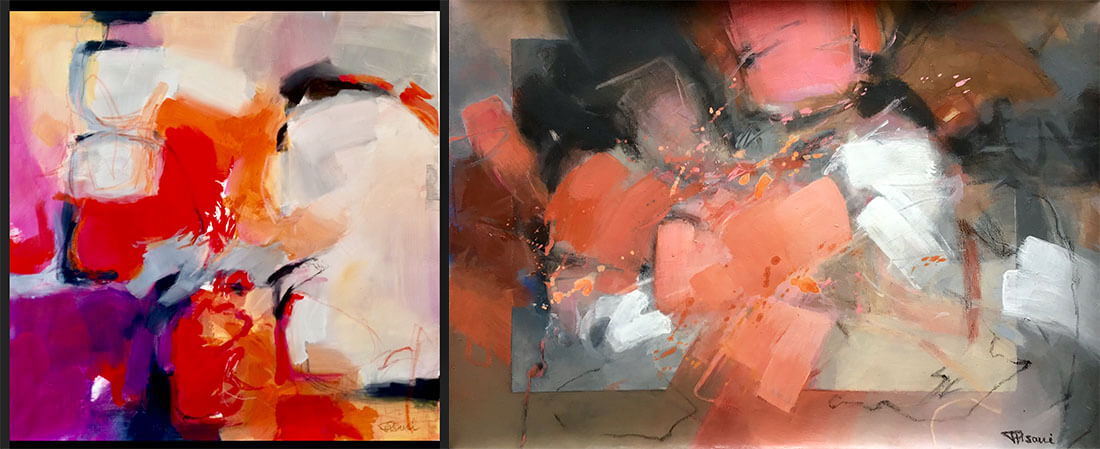
Chrissy now understands the path to her best work

~ Christine Scurr
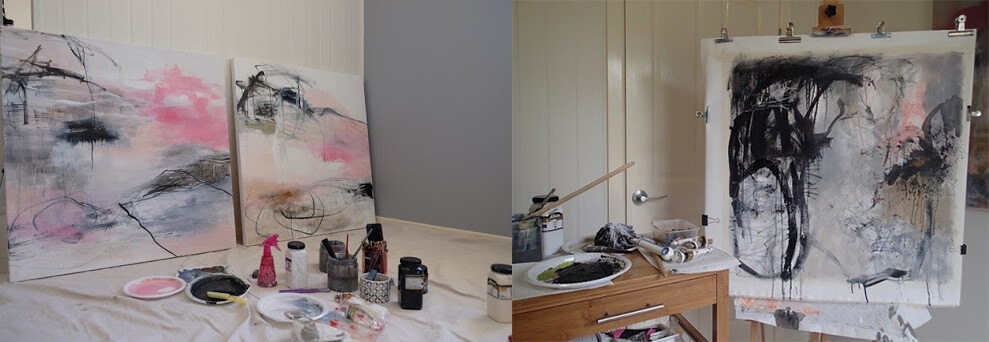
Betty found her own style

~ Betty Franks Krause
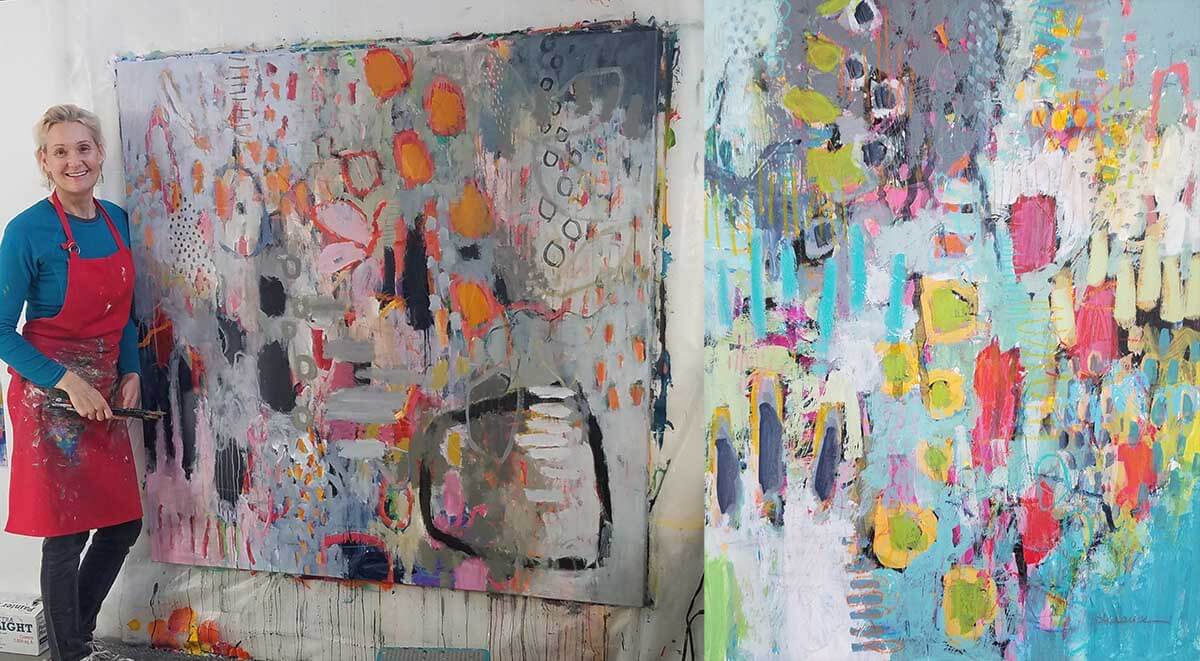
Marian incorporated painting with her yoga practice
The Artist’s Journey Course Work and Nancy’s abiding trust and encouragement are the cornerstone of my artistic development. Watching her simultaneously paint and teach is captivating and spellbinding. I’ve travelled from nascent “yeah kind of” artist to one who races to her studio, eager to spend time painting, experimenting, exploring, allowing, and finally, liking my work. Grateful to Nancy forever! Namaste!
~ Marian Bach

Take Your Art Somewhere New In 2024: The Adjacent Possible
This is a chapter from our newest book The Adjacent Possible: Guidebook & Stories Of Artistic Transformation. It is a kind of “extra credit” chapter, philosophical musings on the nature of being and existence and their relationship to the...

Timing, Art & New Year’s Resolutions
No time is convenient This is a train of thought that will be occurring to a lot of people in the next days as they make their New Years’ resolutions. Anything significant and new in one’s life runs into boundaries and constraints, because...

Art, Beauty, Rembrandt & Botticelli
My earliest memory of art was staring at two Rembrandt reproductions that hung in the living room of my childhood home in Arkansas. (Note: It turns out that both paintings below, once attributed to Rembrandt, may in fact have been created by...
- Meta Quest 4
- Google Pixel 9
- Google Pixel 8a
- Apple Vision Pro 2
- Nintendo Switch 2
- Samsung Galaxy Ring
- Yellowstone Season 6
- Recall an Email in Outlook
- Stranger Things Season 5
Matt Nava and the playable art of ‘Journey’

Despite these humble beginnings, the game went on to collect scads of awards, landing on almost every “best of” gaming list imaginable. It became the fastest-selling game on PlayStation Network in North America, and even landed a Grammy nomination for Best Score for a Visual Media category, the first video game to ever receive such an honor. The game was a hit, but beyond the commercial and critical reception, Journey was clearly a work of art. Roger Ebert be damned.
But with a project like this, developed by a small team of around 12, it needed to work on all levels to succeed. Austin Wintory’s soundtrack had to be memorable. Jenovah Chen’s direction needed to be perfect. Nicholas Clark, Bryan Singh, and Chris Bell’s design needed to be spot on. But before any of that could happen, the art design needed to be exceptional. It needed to convey the message and melancholy mood of the world, and it needed to do so in a way that made the full use of the PS3 hardware without costing the independent developer more than it could afford.
Somehow, all the pieces came together. The look of the game borders in iconic, fitting seamlessly with a brilliant multiplayer mode that doesn’t allow you to speak with the other player or communicate with them beyond the most rudimentary ways. It also has several distinct visual areas that all come to life. It all worked out. Of course, that’s easy to say now that the game has been released.
As the art director of Journey , Matt Nava was responsible for much of the look and flair of the game that went on to receive such high esteem. He made it look easy, as if the game was always in his mind, begging to get out. The truth is far less poetic, and far more grueling.
“It was a real big, blank canvas,” Nava says, looking back. “We didn’t know what it was. All we had was this basic idea of making this multiplayer gamer where the point wasn’t to kill each other, but to work together and have this bonding experience with people online that you don’t even know. Beyond that, it was kind of an amorphous thing, and we had no idea if it was going to work, so there was this kind of ambiguity.”
During the design process of the game, Nava created hundreds of different designs for the character, the world, you name it. Only a small portion of the early concept art actually made it into the game, which recently prompted the release of the book, The Art of Journey .
Written by Nava with a foreword by author Chris Melissinos, it chronicles both the development of the game and Nava’s artwork. It is a must-own for any fan of the game, or anyone interested in one of the fastest growing – and most often overlooked – forms of art being produced today.
While nongamers may not grant Journey ’s art the same level of respect that they might a classical painter along the lines of Rembrandt or Van Gogh, the approach those masters of old took wasn’t that far removed from what game designers are doing today.
Regardless of the time period and medium, any artistic endeavor exists to tell a story. Sometimes that is derived from conveying an emotion, or simply by striving for beauty, but there is a story to be had, even if it is a very singular and personal one that the artists embed in the work, and the person experiencing it re-interprets to fit their own sensibilities. Modern audiences certainly take away a different message from Renaissance art commissioned by the Church than the people of that era did, but neither interpretation is right or wrong.
“Those classical masters were making art that had to communicate, it had to convey a message, it needed to tell a story,” Nava said. “A lot of it was for the Church, showing scenes from the Bible for people that couldn’t read and things like that. But because they needed to communicate, their art needed to be refined in a certain way and they developed these amazing techniques for doing that. Video games do the same thing.
“They need to convey a message, they tell a story or they communicate gameplay with visuals and audio. So that kind of tradition of having these art techniques and using these tricks to create depth or motion with imagery and poses of characters translates directly. So I think it is kind of this continuation in a way, of that same tradition, of creating imagery that has meaning and message.”
From an early age, the younger Nava was a student of art. American illustrators like Howard Pyle became influential as he developed his own style, and he took inspiration from all sources, including video games. Fumito Ueda, the designer of Shadow of the Colossus and Ico , was one influence for Nava, as was the relatively primitive art style of Nintendo 64 games, in all their polygon-drenched glory.
Following high school, Nava was accepted into Otis College of Art and Design, one of California’s most prestigious arts schools. With a list of alumni that reads like a who’s who of 20th century artists, fashion designers, and experimental designers, the school is well known for its ability to change with the times.
There Nava met Jenova Chen, co-founder of thatgamecompany, which had recently released the game Flow . Chen developed Flow with Nicholas Clark as part of his master’s thesis. It was as much a concept as a game, but it quickly went on to be the most downloaded game on the PlayStation Network in 2007 and won several awards for best downloadable game.
The two remained in contact following Nava’s graduation, and after a few animation gigs, Nava was invited to join thatgamecompany as the art director for the studio’s second title, Flower .
“ Flower was starting to get some really good reviews – there was a lot of hype about it, and it was kind of casting this big shadow on us,” Nava recalls. “Could we make something bigger than Flower – better than Flower – that would satisfy the people who enjoyed [it]? And how could we make something even more meaningful, or different. How could we make something that would feel like it was part of the TGC franchise, but also new and exciting? It was a big challenge.”
For TGC, when approaching a game, before they even begin to consider things like gameplay or story, the first step is deciding what it wants the gamer to feel. Everything then comes from that genesis.
“The main thing that we want is to convey a message, or to convey a mood or a feeling to the player,” Nava said. “I think that is the most important thing to begin with.”
Once the main themes and goals for Journey were established, the work fell to Nava, who was responsible for all the concept art, as well as all the texturing. Working closely with the team from the start, Nava and TGC came up with the general idea, and then he went to the drawing board – quite literally. From there he created dozens of conceptual pieces by hand. Most were sent back, but little by little, piece by piece, the game began to take shape.
“We found what the limitations were, and we designed the game around them and spent our time working on the things we could do really well,” Nava said.
Of course, those that have played Journey will know that the game is very much left open to interpretation. There were certain guideposts to help you along and to give you a few ideas as to the nature of the world, the character, and what your quest is, but the game – like any good art – allows you to fill in certain blanks and inject your own interpretation of what it is. This was very much intentional, and solidifies the reputation that TGC has earned.
This concept was so ingrained in the making of Journey that it even infected the developers themselves, and led to several spirited debate.
“Even on the development team itself there were different interpretations about the game, and that was something we were OK with. That is what we wanted our players to experience.”
After three years of development, Journey was released on March 13. It was immediately greeted with near universal acclaim, further increasing the reputation of thatgamecompany, enough so that Sony even released the Journey Collector’s Edition , a collection of the developer’s three games on a single disk, as well as a handful of games designed as part of a competition. The collection even features commentary tracks for the games.
Nava hopes to continue in games and further expand into animation as well. At some point in the future, he’d like to create his own IP with friends. For now though his focus on gaming, even as the industry seems to be pushing away from artistic design and more towards photo-realism.
In a way, the photo-realistic approach is almost easier. The more realistic something is meant to look, the more it can be judged as a success or failure on a technical level. Building a world based on a creative, abstract vision requires an intense amount of teamwork, as well as a group all working on the same page. Striving for photo-realism in a game is something that can be measured by anyone working on the game, but to create a world based on creativity and imagination requires trust throughout the team.
Hyper-realistic titles remain the lifeblood of the industry, and the driving force that continues to challenge developers. But on the fringes, away from the traditional gameplay, there are games like Journey that point to new possibilities, new ways to play, and even new ways to think about gaming.
Journey is potent ammunition in the battle to establish games as legitimate art. It may be one of the best examples that video gaming has potential as a medium for artistic expression, not just thrills.
The success of Journey has shown that there is an audience for games like this. They enrich us as gamers and improve the overall industry. They may also be some of the most compelling art being created in any medium today.
Editors’ Recommendations
- Sony’s cloud handheld, the PlayStation Portal, will only stream certain games
- The Last of Us Part I should launch on PlayStation Plus Premium
- Why playing PS3 games on a PS5 is way harder than it sounds
- Sony reverses plans to close PS3 and PS Vita digital storefronts following fan feedback
- PS3 players reportedly unable to download key game patches ahead of store shutdowns
- Sony PlayStation

It’s hard to believe that the release of the PS3 was over a decade ago. During that time, video game graphics and gameplay have only gotten more realistic with PS4 games and will only get even better with the PS5.
Despite all the advancements and new consoles, you may sometimes be in the mood to revisit some of your favorite games that you played as a kid or teenager. Sifting through all the old PS3 games can feel overwhelming, but if you’re trying to figure out which games are still worth your time, we’ve compiled a list of recommendations. We've also gathered a list of the best PS1 games and PS2 games for the sake of nostalgia.
It's Time to Play l PS4
PlayStation is celebrating its 25th anniversary on Tuesday, and what began as an aborted peripheral for the Super Nintendo Entertainment System has morphed into a colossal powerhouse for the industry. Now, Sony has been awarded a Guinness World Record as the best-selling home video game console brand in history, and the numbers are nothing short of staggering.
As we reach what we expect to be the midpoint of this console generation, we can't help but look to the future. In four years, there's a very good chance the hardware hype cycle will start up once again as Sony plans to release a PlayStation 6. While we're certainly jumping the gun in anticipating it (we're still waiting for a PS5 Pro, after all), we've been taking a moment this month to reflect on this console generation and what we want from the next one based on how its gone.
For the sake of daydreaming, I've put together a list of features I'm already hoping to see on PlayStation 6. Think of this less as an impatient glimpse at the future, though. If anything, it's more of a commentary on what's currently lacking on PS5. I hope to see the inevitable PS5 Pro address some of these issues, but if it doesn't, this is what I'll need to see if the PS6 drops in 2028. Consistent performance

- Arts & Photography
- Individual Artists

Enjoy fast, free delivery, exclusive deals, and award-winning movies & TV shows with Prime Try Prime and start saving today with fast, free delivery
Amazon Prime includes:
Fast, FREE Delivery is available to Prime members. To join, select "Try Amazon Prime and start saving today with Fast, FREE Delivery" below the Add to Cart button.
- Cardmembers earn 5% Back at Amazon.com with a Prime Credit Card.
- Unlimited Free Two-Day Delivery
- Streaming of thousands of movies and TV shows with limited ads on Prime Video.
- A Kindle book to borrow for free each month - with no due dates
- Listen to over 2 million songs and hundreds of playlists
- Unlimited photo storage with anywhere access
Important: Your credit card will NOT be charged when you start your free trial or if you cancel during the trial period. If you're happy with Amazon Prime, do nothing. At the end of the free trial, your membership will automatically upgrade to a monthly membership.
Return instructions

Download the free Kindle app and start reading Kindle books instantly on your smartphone, tablet, or computer - no Kindle device required .
Read instantly on your browser with Kindle for Web.
Using your mobile phone camera - scan the code below and download the Kindle app.

Image Unavailable

- To view this video download Flash Player

THE ART AND JOURNEY OF JOHN PAUL GRANILLO INMATE 26553051 Paperback – June 29, 2024
Purchase options and add-ons.
- Print length 144 pages
- Language English
- Publication date June 29, 2024
- Dimensions 8.25 x 0.34 x 11 inches
- ISBN-13 979-8218446659
- See all details

Product details
- ASIN : B0D8HM3DVC
- Publisher : John Paul Granillo (June 29, 2024)
- Language : English
- Paperback : 144 pages
- ISBN-13 : 979-8218446659
- Item Weight : 15 ounces
- Dimensions : 8.25 x 0.34 x 11 inches
- #89 in Individual Artists' Books
- #282 in Biographies of Artists, Architects & Photographers (Books)
- #2,782 in True Crime (Books)
Customer reviews
Customer Reviews, including Product Star Ratings help customers to learn more about the product and decide whether it is the right product for them.
To calculate the overall star rating and percentage breakdown by star, we don’t use a simple average. Instead, our system considers things like how recent a review is and if the reviewer bought the item on Amazon. It also analyzed reviews to verify trustworthiness.
No customer reviews
- Amazon Newsletter
- About Amazon
- Accessibility
- Sustainability
- Press Center
- Investor Relations
- Amazon Devices
- Amazon Science
- Sell on Amazon
- Sell apps on Amazon
- Supply to Amazon
- Protect & Build Your Brand
- Become an Affiliate
- Become a Delivery Driver
- Start a Package Delivery Business
- Advertise Your Products
- Self-Publish with Us
- Become an Amazon Hub Partner
- › See More Ways to Make Money
- Amazon Visa
- Amazon Store Card
- Amazon Secured Card
- Amazon Business Card
- Shop with Points
- Credit Card Marketplace
- Reload Your Balance
- Amazon Currency Converter
- Your Account
- Your Orders
- Shipping Rates & Policies
- Amazon Prime
- Returns & Replacements
- Manage Your Content and Devices
- Recalls and Product Safety Alerts
- Conditions of Use
- Privacy Notice
- Consumer Health Data Privacy Disclosure
- Your Ads Privacy Choices
Smithsonian Voices
From the Smithsonian Museums

SMITHSONIAN AMERICAN ART MUSEUM AND THE RENWICK GALLERY
Fourth of July Journey Through American Art
Summer holiday with a dash of American art
:focal(1414x814:1415x815)/https://tf-cmsv2-smithsonianmag-media.s3.amazonaws.com/filer_public/20/5c/205c7b08-01a1-427e-ad3f-b297698f0e48/saam-197411812_1.jpg)
Don't let life imitate art (careful with those burning hot sparklers!).
Have a happy Fourth of July!
/https://tf-cmsv2-smithsonianmag-media.s3.amazonaws.com/filer_public/9b/47/9b4710ba-a2d5-4163-9ae8-9e5a8eea4438/saam-200283_1.jpg)
Amy Fox | READ MORE
Social media and Digital Content Specialist

Wirltu Yarlu
Introducing the “Journey”, the new Wirltu Yarlu artwork

The artwork, a collaborative creation by Kaurna, Ngarrindjeri, Narungga, and Wirangu artist Gabriel Stengle, was commissioned by Wirltu Yarlu and is now an integral part of The University of Adelaide Indigenous Unit brand identity.
“The artwork is a testament to the journey of Aboriginal and Torres Strait Islander students, from their time in High School, through the Karnkanthi program, and into University and beyond. It’s a celebration of the connection between Wirltu Yarlu, the University, the students, and the journey of education”, shares the artist Gabriel Stengle.
As a University of Adelaide alumni, Gabriel personally experienced Wirltu Yarlu's impact on her journey through higher education. “At school, I was probably the only Aboriginal student. I joined the Karnkanthi program at The University of Adelaide while still at school, and it was a nice step into university; you are surrounded by like-minded people with similar stories growing up, but from different parts of South Australia, all brought up very similarly. The feeling was like a family”.
For Professor Steve Larkin, Pro Vice-Chancellor (Indigenous Engagement), the new artwork is a proud representation of the transformative work done by his team. “Wirltu Yarlu is all about Breaking down barriers and providing opportunities and support for Aboriginal and Torres Strait Islander people to pursue higher education, helping them achieve their goals and seize their dreams. This new artwork is a powerful symbol of what we do. It’s an inspiring representation of the transformative power of education for the future of Aboriginal and Torres Strait Islander people and culture”

Kaurna, Ngarrindjeri, Narungga, and Wirangu artist, Gabriel Stengle
This new artwork is now part of Wirltu Yarlu’s collateral and merchandising. It showcases a strong First Nations representation to current and future students and staff on campus and at community engagement events.
“It’s a celebration of the connection between Wirltu Yarlu, the University, the students, and the journey of education” Gabriel Stengle, Kaurna, Ngarrindjeri, Narungga, and Wirangu artist
Journey, Artwork by Kaurna, Ngarrindjeri, Narungga, Wirangu artist Gabriel Stengle
Close your eyes and let me take you on a journey that will inspire your soul.
Picture yourself on Kaurna land, where Wirltu Yarlu’s totem of the Sea Eagle stands tall, representing excellence through Aboriginal education. The pink waterholes, showcasing the eagle claw, are joined with journey lines that represent the path that students take from high school to university and eventually into employment.
The journey begins at the corner River, representing the Karrawirra Pari (River Torrens), which connects Wirltu Yarlu to the Kaurna land and its people. The bright waterholes throughout the journey represent the diverse meeting places of Aboriginal and Torres Strait Islander people who come to study at The University of Adelaide. The connected journey lines signify Wirltu Yarlu's acknowledgment and recognition that Indigenous students come from various walks of life.
Wirltu Yarlu's support is evident throughout the journey, and it comes full circle as students achieve success. The bright colours used throughout the journey represent the light of every individual and bring awareness to the journey while building a connection with the broader community.
Finally, the Kangaroo tracks represent Wirltu Yarlu's vision and its journey to always strive for excellence in Aboriginal education by moving forward and never looking back.
This story is a testament to the power of education and the resilience of Indigenous students. It inspires us to embrace our uniqueness, pursue our dreams relentlessly, and never lose sight of our culture and goals. May this story ignite the fire within you and propel you towards a brighter future filled with endless possibilities.

- Previous page
You are using an outdated browser. Please upgrade your browser to improve your experience and security.
Thursday, 04 July 2024

Agenda - The Sunday magazine
- Cover Story
A Journey through Creativity and Appreciation

Sakshi Priya explores the world through the eyes of master artists and emerging talents whose works redefine the boundaries of creativity
Embark on an alluring journey into the vibrant world of art with ‘Detente: A Haven of Artistic Rhapsody,’ an exhibition that celebrates the spirit of creativity and cultural diversity. This exhibition showcase of modern and contemporary Indian and international art invites spectators to explore a variety of artistic themes and narratives, each piece offering a unique perspective on evolution, culture, and society.
Stepping into the gallery feels like entering an enchanted world where each painting tells a captivating story, inviting viewers on a journey of emotions and creativity. The exhibition, featuring works by renowned master artists such as MF Hussain, SH Raza, GR Santosh, Satish Gujral, Manu Parekh, B Prabha, Anjali Ela Menon, Ajay Samir, Anup Kumar Chand, Ashok Bhowmick, alongside contributions from contemporary and participating artists like M Narayan, Bahaar Dhawan Rohatgi, Sanuj Birla, Aditee Garg and more, is a testament to the richness and diversity of contemporary Indian and international art.
The artwork demands to be seen and appreciated by all, showcasing the exquisite talent of each artist. Visitors stand before the paintings, interpreting and admiring the work in their unique way, captivated by the details, patterns, and colours. This experience highlights the immense value and appreciation for art in today’s world. The gallery itself feels like a journey through memory lane which continues to resonate even after they are no longer with us. Their art speaks volumes, as the saying goes, “an artist’s work always stays with us.” Artists like SH Raza, GR Santosh, MF Husain, B Prabha, and Satish Gujral demonstrate their mastery through their paintings, with each piece reflecting their profound skill and artistic vision.
The walls of the gallery exude a mesmerising aura, showcasing the true worth and beauty of these artworks. M. Narayan’s artwork, with its focus on equestrian aesthetics, captures the power and speed of horses through expressionist strokes and dynamic lines. His paintings convey the thrilling energy and elegant beauty of horses and polo players, drawing viewers into a world of vivid colours and bold strokes.
Satish Gujral’s canvas delves into the depths of history, channelling an expressionist grandeur of gesture and space. Bahaar Dhawan Rohatgi’s art invokes a sense of calmness with abstract explorations that blend various mediums. Her pieces unlock the immensity within her artistic journey, revealing layers of emotion and dreams through intricate brushstrokes. Manu Parekh’s work echoes the rich tradition of Indian folk art fused with modernist sensibilities. His paintings evoke a rousing provocation known for their vibrant and dynamic composition that captures the essence of painting.
Aditee Garg’s sculptures are praised for their cultural resonance and narrative depth with graceful curves that almost become performative in nature. Her work invites viewers to join in transporting them to the realm of magnificent creatures through intricate narratives and expansive spaces. The artwork of Anup Kumar Chand is described as a tribute to the majesty of nature, particularly awe-inspiring tigers. His paintings create a world of fantasy shapes where colours seamlessly blend with the background resulting in a harmonious visual symphony. Sanuj Birla’s exceptional painting is noted for its excellence in art, creating dreamy visions inspired by movies and comic books holding a special place in everyone’s heart.
Each artist’s work is celebrated for its uniqueness and ability to evoke a range of emotions and interpretations making the exhibition a truly immersive and inspiring experience for all visitors. The exhibition is not just about showcasing art; it is about honouring the legacy of artists and the impact of their work. It is a celebration of power, grace, and beauty. As visitors immerse themselves in this artistic journey, they are transported to a world where time slows down and the boundaries between reality and fantasy blur. The gallery becomes a testimony to the immersive experience that art can offer, where every piece evokes a beautiful sense of emotion and reality.
Sumer Raj Chadha, the founder of Gallery West End reflects on his appreciation for art, nurtured over the years by his grandmother, Santosh Raj Chadha, a passionate art collector. He says, “This exhibit is a tribute to a true art aficionado and a fervent connoisseur of beauty, our vanguard, late Santosh Raj Chadha, my beloved grandmother. She sowed the seed of love for art and has been a custodian of creative curiosity in our family.” Chadha’s dedication has transformed this exhibition into a platform for artists to showcase their talent and connect with enthusiasts. His commitment to honoring artistic legacies and encouraging creativity shines in every aspect of this remarkable exhibition.
‘Detente: A Haven of Artistic Rhapsody’ is more than just an art exhibition; it is an incredible source of inspiration and an immersive journey into the artistic vision of modern and contemporary artists. It is a place where art speaks to everyone, inviting them to delve into realms of exploration, connection, and inspiration.
Trending News

Voting begins in UK polls; future of Rishi Sunak as PM hangs in balance

Tight security for victory parade of T20 world champs in Mumbai

They're home: India's T20 world champs arrive in Delhi; fans brave rain to welcome players

INDvsZIM: Gill-led new-look Team India lands in Harare for T20Is against Zimbabwe

Colombia draws Brazil 1-1 and will play Panama in quarterfinals

Austria Vs Turkey: Demiral's double helps Turkey beat Austria 2-1

Shah Rukh Khan to receive career achievement award at Locarno Film Festival

US eliminated from Copa America with 1-0 loss to Uruguay

Lot of time for me to sleep, for now I want live every second of this win: Rohit

Australia doubles visa fees for international students; Indians to be hit

Would be an honour to be running mate of Trump: Ramaswamy

Pakistan court rejects appeals by Imran Khan & wife to suspend sentence in illegal marriage case
State editions, modi takes a dig at congress for defending aap after kejriwal arrest, security at rahul's residence stepped up, bjp leaders protest against rahul's remarks against party, kejriwal moves hc seeking bail in liquor policy scam case, 100 per cent humidity makes city weather suffocating for residents, panel members reject maliwal’s claim of aap dismantling dcw, sunday edition, on a fun filled pawcation, from the pen of a grounded poet, journey to an expanded self awareness, tangra tales, disappointing service mars fine dining experiences, guruspeak | do you pray, e-mail this link to a friend..


Random post
- Photography
- Illustration
- installation
- architecture
- posters and prints
Animation Film Social Issues
#birds #health #healthcare #short film #video, raising awareness of systemic racism in healthcare, a stork embarks on an ‘impossible journey’, july 2, 2024, kate mothes.
The timeless tale of the stork delivering babies is, like many myths, difficult to trace to a single source, as the story unfolds in folklore throughout Europe, the Americas, North Africa, and the Middle East. In the short film “Impossible Journey” —directed by YUCA and produced by The Youth Company and Colossal (no affiliation)—the creature’s vital mission sets the scene for a critical and poignant message.
When one determined stork takes off from the Tree of Life, we follow it and its precious cargo through heavy weather and around a spewing volcano before eventually landing inside a modern maternity ward. A beautiful newborn is unfurled from a cloth, and as the scene pans out, we learn the child is the only Black baby in the room. The exhausted bird sheds a tear, and the child grasps for a single, falling feather.
“The C-section is where they lock our partners, our wives, at,” a male voice says as the animation cuts to a room of people seated in a circle. “A place of anxiety, where you wait, and wait, and wait, and wait for someone to be there. But that someone never comes. No one ever comes. An unprivileged area to punish us for a capital sin: being born with the Black color of our skin.”

All images © Aster and Ashé Birthing Services
“ Impossible Journey ” is dedicated to the memory of Amber Rose Isaac, a young Black woman who lost her life due to hospital negligence during a difficult birth. “Maternity is a beautiful yet unequal journey, ” reads overlaid text, sharing the stark statistic that Black women are three times more likely than white women to die from pregnancy-related causes. The film highlights the importance of making healthcare safer and more accessible, highlighting the work of Black women-founded and Black-led organizations dedicated to crucial birthing and reproductive justice.
A keystone of the project is its focus on the Black Maternal Health Momnibus Act , a proposed law comprising 13 bills with the aim of addressing systemic racism in healthcare. The bills include making investments to improve social health determinants, such as housing and nutrition; expanding the maternal health workforce; improving data collection and quality measures; and funding preventive care and support services for Black families.
“Impossible Journey” is the winner of two Silver Cannes Lions awards in 2024 for both film and digital craft. Find more on the project’s website , where you can listen to more true stories that went into the making of the film and find more information about the Momnibus Act.

Do stories and artists like this matter to you? Become a Colossal Member today and support independent arts publishing for as little as $5 per month. You'll connect with a community of like-minded readers who are passionate about contemporary art, read articles and newsletters ad-free, sustain our interview series, get discounts and early access to our limited-edition print releases, and much more. Join now !
Share this story
Also on colossal, related posts on colossal about birds health healthcare short film video.

Trending on Colossal

IMAGES
VIDEO
COMMENTS
Art, in essence, is a beautifully balanced act of performative alchemy - a wondrous fusion of emotion, technique, and medium, diligently shaped by the sculptor's skill, the painter's eye, the musician's melody, the writer's pen. It is a multi-dimensional language, singing its harmonious symphony with every stroke, chisel, note, and word.
Process: Journeys in art making. Journeys in art can also be those that relate to the formal processes of art making. Artist Paul Klee famously described the process of drawing as 'taking a line for a walk'. Some artists create work using systems that dictate the journeys they will make in their creative process.
The Voyage of Life is a series of four paintings created by the American artist Thomas Cole in 1840 and reproduced with minor alterations in 1842, representing an allegory of the four stages of human life. The paintings, Childhood, Youth, Manhood, and Old Age, depict a voyager who travels in a boat on a river through the mid-19th-century American wilderness.
On Artists' Journeys and Their Meanings. Many artists undertook arduous travels to reach new environments in search for inspiration. These often resulted in lifechanging experiences for artists, and treasures for art history. As the summer comes to an end, most of us look back on our recent journeys - be it far or close.
A voyage into the artistic life of Vincent Van Gogh is a journey through a prism of intense emotion and dramatic imagery. Esteemed as one of the most profound and significant artists of the late 19th century, Van Gogh's life was teeming with personal struggle and a passionate ardour for creativity. Nurturing a desire for.
Best Traveling Paintings: Leon Belly, Pilgrims Going to Mecca, 1861, Musée d'Orsay, Paris, France. Before trains and cars, camel caravans crossed the desert to deliver goods and offer safe passage to travelers. Leon Belly's orientalist painting shows a caravan heading towards Mecca, a place of pilgrimage for all Muslims.
Authors: Sara Jatcko, Terra Foundation for American Art Manuel Valderrama, Lane Tech College Prep High School Summary: By conducting close readings of works of visual art and poetry, students will explore how artists connect physical journeys with inner journeys of human experience. Students will also write narratives that depict real and imagined journeys. Lesson Overview […]
1265-1321. These words by the great poet and writer in the fourteenth century, Dante Alighieri, speak to us across the centuries of essentially the hero's journey, of stepping into the unknown from a place of knowing, into the unknown. And it's scary. And this is what we're going to talk about today.
A journey can change how we see ourselves and the world, whether it is a physical journey or a journey of the imagination. A close reading of a work of art can take us on a journey of the imagination. Objectives. Students will read closely to determine what a text says explicitly and to make logical inferences from it.
Authors: Joel Javier, Intuit: The Center for Intuitive and Outsider Art Sheri Snopek, Columbus Elementary School Kimberly Houston-Moore, Fort Dearborn Elementary School Summary: In this lesson, students explore real and imagined journeys by analyzing the life and artworks of Joseph Yoakum. Students then write narratives and create artworks of their own real or imagined journeys. […]
Lifted by the power of human connection. and reached the surface thankful for air. Flown with birds and planes and cats. And have reached out to the most colorful of lights. I've witnessed dry fields turn to flames, then black. And in those fields, I've run through grass tall and green again.
A Journey that wasn't Pierre Huyghe. 2005. Lost Kathy Prendergast. 1999. The Last Voyage of Henry Hudson The Hon. John Collier. exhibited 1881. A Hundred Mile Walk Richard Long CBE. 1971-2. ... Land art or earth art is art that is made directly in the landscape, sculpting the land itself into earthworks or making structures in the landscape ...
In addition, each of these movements brought new perspectives and techniques to the art world, and understanding them can provide valuable context for appreciating a wide range of artworks. Conclusion: The Journey of Art Appreciation. Art appreciation is a lifelong journey, filled with discoveries, surprises, and personal growth.
Introduction. Art has the power to evoke emotions, spark imagination, and transport us to different worlds. Art Appreciation goes beyond mere observation; it's about developing a profound connection with artistic expression. In this article, we'll delve into the definition of Art Appreciation, discuss its importance, and provide a roadmap for your journey into the captivating realm of art.
The Art of Journey is a behind-the-scenes exploration of the ideas and visual development that went into the critically-acclaimed video game. Written by Journey Art Director, Matt Nava, the book shows the stylistic influences, narrative devices and game design goals that made Journey what it is.The Art of Journey includes concept art, intricate pencil drawings, and 3D models.
The Voyage of Life traces a pilgrim's journey along the "River of Life.". In "Childhood" a golden boat emerges from a darkened cave—a mysterious earthly source—from which a joyous infant reaches out to the world with wonder and naivete. Rose light bathes the scene of fertile beauty as an angelic figure guides the boat forward.
Julie Mehretu's Long Journey Home. Wildfires, refugee camps and the Arab Spring might be her primary sources. But a retrospective at the Whitney affirms she is an abstract painter, first and ...
Sumathi Ramaswamy's book 'Gandhi In The Gallery' is a stunning visual journey of 130 artists and their artworks inspired by the Father of the Nation Updated - December 03, 2020 11:00 am IST ...
Join us on a Journey of Color as we highlight thirty-four objects that reveal how different cultures obtained, produced, and used color to individualize their creations and tell layered, universal stories. Look for the orange "Journey of Color" bar on select labels throughout the galleries to learn more. Journey of Color is part of the 2023 ...
The Art of Journey, a behind-the-scenes exploration of the ideas and. visual development that went into the critically-acclaimed video game. Written by Journey Art Director, Matt Nava, the book shows the stylistic. influences, narrative devices and game design goals that made Journey. what it is. Inside, readers will discover the thoughtful ...
Discover artworks, explore venues and meet artists. Art UK is the online home for every public collection in the UK. Featuring over 300,000 artworks by over 50,000 artists. ... They journey together in the heart-shaped confines, but as the levels of the ship descend it becomes clear that passengers are divided based on privilege that reveals ...
Nancy encourages you to find the nascent, unexpressed parts of yourself, give voice to your subconscious experiences, and finally express YOU in your art and life. Founder of The Artist's Journey® and The Adjacent Possible® workshops and courses, Nancy has led over 50,000 students on their creative journeys.
From a few rough drawings to becoming one of the most talked-about games of the year, the tale of how Journey came to shake up the gaming community is a journey itself. Art director Matt Nava ...
Diverse Artworks Explore a wide range of John Paul's art, from murals to fine paintings, each piece revealing a part of his soul and his journey. Social and Cultural Impact Understand the broader implications of John Paul's work, addressing themes of identity, community, and the struggle against systemic injustices.
Morris Kantor, Baseball at Night, 1934, oil on linen, Smithsonian American Art Museum, 1976.146.18 Gift of Mrs. Morris Kantor Baseball, apple pie, and the Fourth of July.
I am thrilled to share with you the story behind my latest artistic endeavor - the "Nature's Scenes: 12 Days of Botanical and Landscape Art" challenge. This project was a deeply personal journey that pushed me to explore new horizons and step out of my comfort zone, blending my love for bo
Art & Exhibitions Kandinsky's Roving Creative Journey Comes to Life in Amsterdam "Kandinsky" at the H'ART Museum brings together 60 of the painter's masterpieces.
"The artwork is a testament to the journey of Aboriginal and Torres Strait Islander students, from their time in High School, through the Karnkanthi program, and into University and beyond. It's a celebration of the connection between Wirltu Yarlu, the University, the students, and the journey of education", shares the artist Gabriel ...
Embark on an alluring journey into the vibrant world of art with 'Detente: A Haven of Artistic Rhapsody,' an exhibition that celebrates the spirit of creativity and cultural diversity. This ...
The timeless tale of the stork delivering babies is, like many myths, difficult to trace to a single source, as the story unfolds in folklore throughout Europe, the Americas, North Africa, and the Middle East. In the short film "Impossible Journey" —directed by YUCA and produced by The Youth Company and Colossal (no affiliation)—the creature's vital mission sets the scene for a ...